- Good Writing
- Revising & Rewriting
- Nonfiction Writing
- Academic Writing
- Travel Writing
- Literary Agents
- Getting Published
- Fiction Writing
- Self-Publishing
- Marketing & Selling Books
- Building a Blog
- Making Money Blogging
- Boosting Blog Traffic
- Online Writing
- eZine Writing
- Making Money Online
- Non-Fiction Writing
- Magazine Writing
- Pitching Query Letters
- Working With Editors
- Professional Writers
- Newspaper Writing
- Making Money Writing
- Running a Writing Business
- Privacy Policy

How to Write a Speech for a Nonprofit Fundraiser: Tips & Examples
- by Laurie Pawlik
- February 2, 2024
- 10 Comments
These tips for writing fundraising speeches include a real example of a successful inspirational speech for a charity. I share the actual talk my Little Sister and I gave at a Big Sisters Fundraising Gala in Vancouver, BC, Canada. We received a standing ovation and raised more money for our charity than the planning committee hoped for!
Writing a strong, meaningful speech for an inspirational charity or nonprofit organization requires heartfelt emotion and true stories of healing, support, and love. There is a great deal of competition for people’s time, energy and money. Hundreds of excellent, helpful, service-oriented nonprofit charities are trying to raise finances and other forms of support.
I’m a volunteer Big Sister with the nonprofit organization Big Sisters/Big Brothers (which is almost worldwide). My “Little Sister” is now 22 years old. We were officially matched when she was 11. The Big Sisters organization asked us to give an inspirational speech at their annual fundraising gala with Big Sisters at a posh hotel function in Vancouver.
The following three tips will help you learn how to write persuasive stories, write an inspirational speech for your organization, and feel confident that you’re doing the best you can to raise funds and support the people who benefit from your nonprofit. nonprofit organizations.
After these three tips, my true story and example of an inspirational speech will further explain and describe how to write a fundraising speech for a charity event.
3 Tips for Writing Inspirational Speeches
Remember to infuse your speech with passion and optimism. Appeal to the values and aspirations of your audience, and don’t forget to express gratitude for their potential support.

1. Ask one of your nonprofit’s recipients to tell a compelling story
Share a story that connects emotionally with your audience. Share a real-life example or personal experience (such as my story in the sample speech below) that highlights the impact of your organization’s effect on people.
Most importantly, ask someone who has actually been helped by your organization to share their story. First-hand narratives are more interesting and relatable. They are irrefutable proof that your nonprofit’s contributions make a tangible difference in someone’s life. This personal touch creates a stronger emotional connection, encouraging people to get involved, donate money, and support your organization.
2. Hi ghlight your organization’s achievements and goals
Outline your nonprofit’s achievements. Be passionate and excited at how far you’ve come! This won’t be superficial or fake passion if you ask someone who is truly grateful for your nonprofit organization and will share their story during your fundraising speech.
Also, make sure you are emphasizing the positive impact your nonprofit has had on individuals or communities. Paint a vivid picture of what your organization has accomplished and the positive change you aspire to bring going forward. This helps instill confidence in potential donors, showing them that their support will contribute to your nonprofit and the people’s ongoing success and growth.
3. Clearly articulate your nonprofit’s need
Finally clearly communicate why your organization nonprofit needs financial support. What will you do with the money or other resources?
Break down the specific areas where funds are required and explain how these resources will be allocated. Are you hoping to fund a specific project, expand outreach efforts or support ongoing operations that are working? Be transparent. This helps donors understand the concrete impact their contributions will have. Your honesty fosters trust and commitment.
Below is the inspirational speech my Little Sister and I gave at a fundraising gala dinner (not quite a “charity ball”, but close). In the speech I shared what it’s like being a Big Sister. Below, I break the speech down into specific parts so you can use the format as a sample inspirational speech for your own charity event.
If your nonprofit doesn’t blog, read How to Start an Inspirational Self-Help Blog to Inspire and Encourage Others .
Example of a Fundraising Speech for a Nonprofit Organization
Speaking at this charity event taught me that the most inspirational speeches and best fundraising ideas have to involve sharing how your charity or nonprofit organization actually affects people’s lives. Weave true, heartfelt stories, emotions, and touching experiences into your inspirational speech. Include real people who have benefitted from your nonprofit organization or charity – people who are sincerely grateful for your work.
Use the details I highlighted in bold as hints that will make your own inspirational speech and charity event excellent.
We got a standing ovation after we spoke at this fundraising gala dinner, by the way! It was AWESOME. At the end of my inspirational speech, I share a link to an article about public speaking tips. Also, Big Sisters’ goal was to raise $210,000 for the charity, and they succeeded. 🙂
And that’s your first tip for raising funds for a charity: Know how much money you want to raise. Be bold, and don’t be shy about asking for money for your nonprofit organization.
Speaking at a Big Sister’s Fundraising Dinner for Charity
Word for word, this is the inspirational speech I gave at the Big Sisters Fundraising Gala.
Hi everyone, I’m Laurie, and this is my BIG Little Sister, Sarrah. (note to reader: this is funny because my Little Sister is physically bigger and taller than I am. Ha ha!).
How this charity changed my life
Without the Big Sisters organization – and all the sponsors, volunteers, staff, and board members – I would never have met my Little Sister Sarrah. And I would’ve missed out on one of the highlights of my whole life: being a Big Sister.
Without Big Sisters, I would have also missed out on being a Little Sister! When I was 11 – about 32 years ago, give or take a few dozen years – I had my own Big Sister. We were matched for about a year, before I moved to a different city. Even though we were only together for a short time, my Big Sister changed my life. I’m not even sure what she did or how she did it. It was just that she made time for me and listened to me.
My Big Sister made me feel good about myself, and I am 100 per cent certain she changed my life in ways I can’t even comprehend. My mom struggles with schizophrenia and I’ve never had a father in my life, and having a Big Sister made me feel happier, more confident, and more loved.
What this inspirational charity does for girls and women
I believe Big Sisters changes girls’ lives by making them feel valuable, special, and unique.
The more confident and loved a girl feels, the more likely she’ll make good decisions that help her succeed. And it’s not just individual and families who benefit from – the whole community is positively affected when girls make smart choices! So, I was wrong when I said I’m not sure how my Big changed my life. It was simply that she changed how I saw myself and how I felt about myself. This in turn changed how I saw and interacted with the world.
The beauty is that a Big Sister doesn’t have to be university educated, or be young, or cool, or trendy, or wealthy – she just has to have an extra couple of hours a week to spend with a girl.
What life would be like without this charity
This is an important part of an inspirational speech at a charity event: what if the organization didn’t exist?) If I didn’t have a Big Sister, I don’t know if I would have become a Big Sister myself. For me, it just seemed like a “no brainer.” But, even though I know firsthand how powerful it is to have a Big Sister, I was a bit worried about committing to a year – or more!- to being a mentor.
Problems or worries faced by the volunteers, charity, or organizers of the fundraiser
My biggest worry was that my Little and I wouldn’t connect. Spending 2 to 4 hours together once a week is a big commitment – what if we didn’t like each other? What if we had nothing in common? I feel so lucky to be paired with Sarrah. Our Big Sisters counselor, Michelle, did a wonderful job matching us.
The first time we ever met was in a park right beside her home. Sarrah’s mom brought homemade cookies and fresh fruit, and I was so touched at her thoughtfulness. I brought my dog Georgie, because I thought she’d help break the ice. I was right; the ice was broken and has stayed broken the whole time!
Successes (every inspirational speech needs hope and joy!)
Sarrah is so smart, curious, interesting, and fun to be with. She’s open to trying anything and everything, and looks on the bright side of everything that happens. She takes after me that way! I’m particularly impressed that Sarrah is so willing to try new things, because she was isolated for the first few years of her life. She didn’t’ go to school until grade two, and now she’s getting A’s in grade seven. I love that she wants to be a doctor or a writer when she grows up – and I’m encouraging her to be both.
Specific examples of how the charity operates
We’ve done lots of fun things together, as you can see from our photos…but my favorite is walking our dogs at Ambleside beach and getting a slurpee. Sarrah’s favourite slurpee flavour is everything all mixed together or when I was growing up it was called“Swamp Water”, and mine is plain old coke and Dr Pepper. So far, slurpee flavours is the only thing we disagree on! We talk a lot, and Sarrah has shared challenges she faces at school with her friends. She’s also talked about the changes she’s experiencing in her life, and I love being a sounding board for her.
One of my best memories is when I gave Sarrah the choice between doing two super fun fantastic activities. She said she didn’t care what we do, she just wants to spend time together. That was one of the most beautiful, kindest things anyone has ever said to me! I feel the same way about her – it really doesn’t matter if we’re walking the dogs, surfing the waves or packing a Christmas Shoebox for Operation Christmas Child . It really is good to just be together.
Why this nonprofit organization is so important
The biggest change I’ve seen in Sarrah is her increased confidence in herself. When we were first matched, our first outing was the Big Sisters picnic in Stanley Park – in the pouring rain! Sarrah was so shy and quiet, and she spoke so softly that people couldn’t hear what she was saying.
Now, I am so proud of how confident she is. When we were at the library last week working on our speeches, she went to the librarian by herself to ask for a guest pass for the computer. Before, she would’ve been too shy to do this alone. She takes the bus by herself now, and even has a job delivering papers. Her first job!
Conclude the inspirational speech with an “ask”
Being a Big Sister is amazing – and I’m so grateful to the Big Sisters organization and all its supporters, volunteers, staff, and sponsors. Because of you all, Sarrah and I have a friendship that neither of us will ever forget. I look forward to many more years walking alongside Sarrah as she enters high school, starts thinking about boys as more than pests (which I hope doesn’t happen for a long long time!), and drives me to the 7-11 for our slurpee breaks.
Thank you! Thank you so much for making such a Big difference in our lives, and for giving me and Sarrah the gift of friendship.

Are you stuck for ideas on how to write a fundraising speech? Read Practical Tips and Writing Inspiration for When You Can’t Write .
Summary of an Inspirational Speech
In your charity fundraising speech, describe:
- How and why your charity is life-changing, both specifically and generally
- The challenges your charity has overcome, or is overcoming
- The successes you’ve faced as a charity or an individual
- End your inspirational speech with an ask for a specific amount of money. Don’t be shy about asking for money – that’s what charity events and fundraising galas are for.
This inspirational speech is from my heart, which is what made it work. If you’re giving a speech at a charity event, write it from the very core of you! The more authentic and sincere you are, the better your fundraising efforts, inspirational speech, and charity event will be.
Why are you searching for charity speeches? Feel free to share your nonprofit organization’s information here — including what you’re raising money for. This is a good and safe place to practice your fundraising efforts 🙂 Feel free to share links to your organization or charity event.
Comments Cancel reply
Your email address will not be published. Required fields are marked *
Save my name, email, and website in this browser for the next time I comment.
Notify me of new posts by email.
10 thoughts on “How to Write a Speech for a Nonprofit Fundraiser: Tips & Examples”
Thanks for these tips. I’m trying to convince the manager of our nonprofit to approve a fundraising dinner, but she thinks it’s too expensive. The costs will outweigh the benefits of an organizing a dinner with speeches, she says. I really think we should try it because our charity hasn’t done it before, and I know our clients will be willing to participate. How do I convince my supervisor to approve a fundraiser?
Good question, Jeremy! I understand your manager’s hesitation because sometimes it can look bad for nonprofits to spend alot of money trying to raise funds. It can look like a misuse of the money the organization has, even though it’s money well spent.
Convincing your manager to approve a fundraising dinner requires a strategic approach.
Here are three pieces of advice:
1. Prepare a comprehensive cost-benefit analysis that outlines the potential expenses and the expected returns. Clearly demonstrate how the investment in the fundraising dinner aligns with your nonprofit’s goals and mission. Break down the costs, including venue, catering, and any other expenses, and juxtapose them with the anticipated revenue from the event. Highlight additional benefits beyond financial gains, such as increased community engagement, brand visibility, and the opportunity to connect with potential long-term donors.
2. Be creative! Showcase the uniqueness and innovation behind organizing a fundraising dinner. Since your charity hasn’t done it before, emphasize the novelty and the potential for creating a memorable experience for participants. Highlight how a dinner event can provide a platform for networking, community building, and sharing the organization’s mission in a more personal and interactive way. Emphasize how this approach can set your charity apart from others, attracting attention and support from a broader audience.
3. If you know your clients are willing to participate, use their enthusiasm to your advantage. Collect testimonials or statements from clients expressing their support for the fundraising dinner. These testimonials can serve as powerful evidence of community backing and the potential impact of the event.
Additionally, propose involving clients in the event itself, whether through testimonials, personal stories, or participation in some aspect of the dinner. This not only adds authenticity to the event but also creates a stronger connection between the donors and the cause.
By combining a solid financial argument with a focus on innovation and client engagement, you might be able to convince your manager that a fundraising dinner with an inspirational speech will be profitable for everyone.
Nonprofit Writing – How to Write a Donation Letter to Raise Money
Include a story – tap into the reader’s emotions. The donation letters I’ve written included stories about sick babies, hospitals in need of new medical equipment, and people losing their lives to disease. I interviewed patients, doctors, and nurses, and share their experience from their point of view. Here’s a snippet of a donation letter that asked for money for incubators for the hospital — it’s from a mother’s perspective: “I cried so much that first week. Not only was childbirth stressful, coping with a serious case of jaundice was almost too much! I couldn’t hold my baby unless I was feeding her. I felt scared and helpless.”
Be dramatic, and use powerful “please help us” words. At first, nonprofit writing – especially writing donation letters – may seem false and overly dramatic! But, that’s how nonprofits encourage people to donate. My hospital clients encouraged me to write sentences such as, “Funding for this hospital is literally a matter of ‘life and death’ – and your family could be next,” and “I was one of many new mothers who felt helpless and frustrated. You don’t realize how powerless you are as a parent until your baby has to wait for an incubator.” It felt over the top at first, but I understand the need to impress upon potential donors with strong writing. A weak, timid request doesn’t help nonprofits raise money.
Use italics, bold font, and underlining. Set your most powerful sentences apart by centering them and leaving white space around them. Use italics, bold font, and underlining to specifically ask for money in the donation letter. Here’s a sentence that I bolded, underlined, and set apart: “I ask you to give a gift to this hospital to alleviate the need I saw at the hospital – and keep ensuring the best care is given.”
Tie the donation letter to a holiday or special occasion. The hospital I write for sends their donation letters on Mother’s Day, Christmas, Easter, and hospital anniversaries. It’s more effective to connect your request for money with a heartwarming occasion – especially if a personal story can be naturally woven into the theme of the holiday.
Keep the donation letter short. Two pages should be more than enough to share a story, explain why the nonprofit needs to raise money, and make the request. People don’t have time to read long letters, and they may never get to the end of the letter – where the final appeal for money is made.
Make it easy for readers to donate money. Include a tear-off slip at the end of the donation letter, giving people the option to donate different amounts of money. Include tax credit information, a contact name and number for donors who want more info, and different ways to make a donation.
Great article Laurie! A few other tips for nonprofit fundraising letters and speeches:
– Tie your ‘ask’ to something specific. For example: “Your $35 donation will feed a hungry child for a week.” – Include something in the letter that encourages the reader to respond, even without a gift. For example, several of the hospital clients I write for encourage donors to sign and return a special Holiday Card to display and brighten the hospital for patients at Christmastime. Most people will include a gift with the card, but might not have responded without it. – There is a place for longer letters. As a fundraising account director, I found that longer letters (4 pages) worked well for some clients — usually when prospecting for new donors to their cause. It all depends on the story, the cause and how much information is needed make a compelling case for support.
I’m the founder and CEO of Frankel Foundation For Diabetics, an NGO to serve, support and advocate for children, adolescence and adults living with diabetes and their families in Ghana, West Africa. Its less than a year old. It’s in honor of my mom and my 15 year old son who are both diabetics. And am also diabetic. Ill be launching it in Worcester, Massachusetts and looking for a sample speech for our fundraising event. I love your inspirational speech. Very heart touching.. God bless you.
Hi I have a speech to give tomorrow in a charity dinner in church, we’ve been planing for three months now .We are called Society of St Vincent de Paul at St Denis catholic church Bariga in Lagos . My mission tomorrow is to drive words into their soul and sparkly that nerve of charity i know exists in us all.
Thanks for this write up , though not exactly what i need but it has shown me how i need to work hard to get a convincing speech to touch my audience
How did your speech go, Ifeanyi? Were you nervous giving the speech, or did you find the charity dinner surprising in anyway?
I hope it was great 🙂
Hi. I am glad I found your article because I am just getting into motivational speaking, and I wanted to know how to write my speech. My friend has a nonprofit organization, and she will need me to be her inspirational speaker. Do you have any more tips?
Susan, thanks for your information.
I hadn’t thought about the language and geographic barriers when writing donation letters…this is great to know.
I’ve written email appeals for nonprofits, and with email, it’s even more important to keep things short and have a clear to action (usually a hyperlinked request for donations that takes the reader directly to the donations page). Storytelling is a powerful way to appeal to the reader’s emotions, but unfortunately, some nonprofits have a tough time collecting those stories.
For instance, my main nonprofit client offers programs in developing countries, so there’s a language barrier and also a geographic barrier between the people working in the trenches and the ones in the headquarters writing creative briefs. Sometimes there are confidentiality issues as well. In cases where we can’t get a brand new story, sometimes we’ll use statistics to put things into context and demonstrate the severity of the situation. (For instance, “every XX seconds, a child dies of the preventable, yet deadly disease known as malaria.”)

10 Short Donation Message Examples (For Each Type, With Tips)
The power of a well-crafted donation message can never be overstated. A short and concise donation message that resonates with potential donors can make the difference between a successful fundraising campaign and one that falls short. As the world becomes increasingly digitized, the need for compelling and persuasive donation messaging has never been greater.
A well-written short donation message can cut through the noise in a crowded and competitive online space and motivate individuals to take action. Whether you are a seasoned non-profit professional or just starting out, understanding the key elements of a successful donation message is critical to your success.
In this article, we will explore some of the most effective short donation request message examples and the key elements that make them effective. By the end of this article, you will have a clear understanding of what it takes to craft a persuasive and thought-provoking short donation message that inspires giving.
Here are 10 Short Donation Message Examples with their context:-
General Short Donation Message Examples
Short donation message examples for schools, short donation message examples for hospitals, short donation message examples for churches, short donation message examples for animal charities, short donation message examples for art charities.

“Donate and be the sunshine in someone’s life during the storm. Your kindness can make a world of difference.”
This message stands out because it presents donating as an act of compassion and a way to comfort someone in difficult times. It appeals to donors’ emotional side, doing the act of giving feels personal and impactful.
“Every donation brings us one step closer to a world of peace and equality. Please give generously.”
This message presents the donation as part of a larger mission toward a better future. It appeals to the sense of purpose and positively impacts the world.
“Let’s leave a legacy of love and compassion for future generations. Your donation can help make that a reality.”
This message presents the donation as a way to create a lasting impact, not just for the present, but for future generations. It appeals to the sense of responsibility and making a difference beyond one’s lifetime.
“Imagine a world without suffering and poverty. You can make that vision a reality with your donation today.”
This message tries to change the world positively and turn a vision into reality. It appeals to the imagination and creativity of the donors, and doing the act of giving feel empowering.
“Help make a difference today by donating to our cause. Every little bit helps!”
This message stands out because it emphasizes that even small donations can significantly impact. It encourages people to give what they can and helps to remove the stigma that only large donations can make a difference.
“Join us in creating a better future for all. Your donation can make a world of difference!”
This message presents the donation as part of a larger movement toward positive change. It appeals to community and collaboration and encourages people to join the effort.
“Donate now to support those in need and create a brighter tomorrow for everyone.”
This message stands out because it presents the donation as a way to provide immediate support and make a positive impact in the future. It appeals to the sense of urgency and the desire to make a difference.
“Your generosity can change someone’s life. Please donate now and make a positive impact.”
This message stands out because it presents the donation as a way to directly and personally impact someone’s life. It appeals to the emotional side of donors and encourages them to act with kindness and generosity.
“Together, we can create a world that is full of kindness and compassion. Your donation can help make that happen.”
This message portrays the donation as a way to work towards a common goal of creating a better world. It appeals to the sense of community and collective effort in making a positive impact.
“Make a difference in someone’s life with a simple donation. Your support can bring hope to those in need.”
This donation message stands out because it presents the donation as a simple act that can profoundly impact someone’s life. It encourages people to act with kindness and generosity, emphasizing the power of even a small act of giving.
Now that you know some of the general short donation messages, let’s see some of the short donation messages for major nonprofits:

- “Invest in our future; donate to our school today. Your generosity can help shape the minds of tomorrow.”
- “Education is the key to a brighter future. Your donation can provide opportunities for students to succeed.”
- “Help give our students the tools they need to succeed. Your donation can make a lasting impact on their education.”
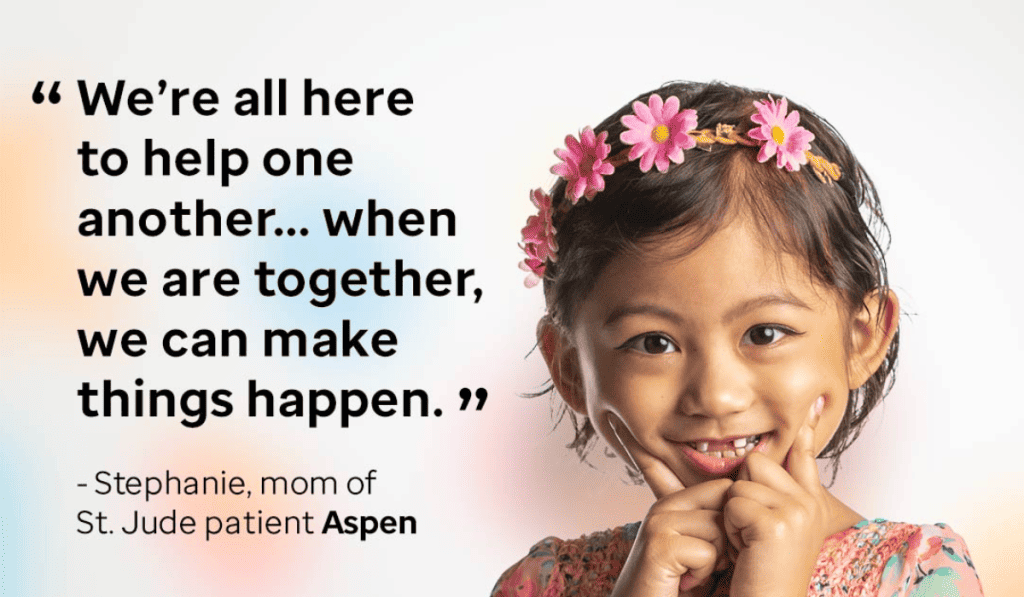
- “Save a life today with a simple donation. Your generosity can provide vital medical care to those in need.”
- “Your donation can bring comfort, healing and hope to those in their greatest time of need.”
- “Invest in the health and well-being of our community. Donate now to support our hospital’s mission.”
- “Donate to support our mission of spreading love, kindness and hope. Your generosity can make a world of difference.”
- “Join us in our mission to create a more loving and compassionate world. Your donation can help us make that a reality.”
- “Your support can help us provide comfort and hope to those in need. Please donate now to our church’s mission.”
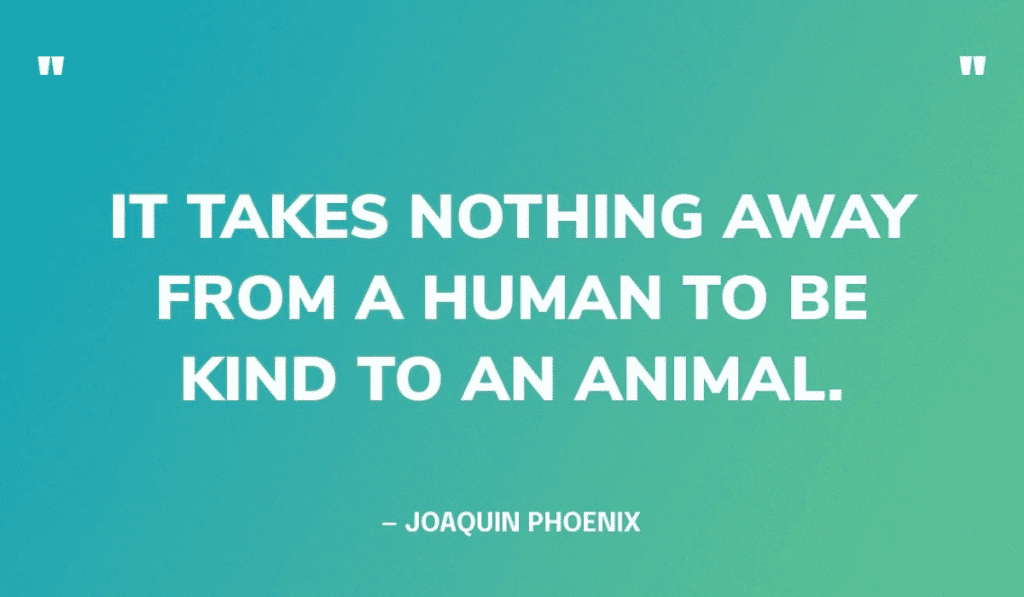
- “Help give a voice to the voiceless. Your donation can support our mission to protect and care for animals.”
- “Animals can’t speak for themselves, but you can. Donate now to help provide them with the love and care they need.”
- “Be the change you wish to see in the world. Your donation can help create a better future for all animals.”

- “Art has the power to bring joy and inspiration to our lives. Your donation can help preserve and promote the arts.”
- “Help support the artists of tomorrow. Your donation can give them the necessary resources to create and inspire.”
- “Invest in the arts and help bring beauty and creativity to our world. Donate now to support our art charity.”
Text Donation Message Examples
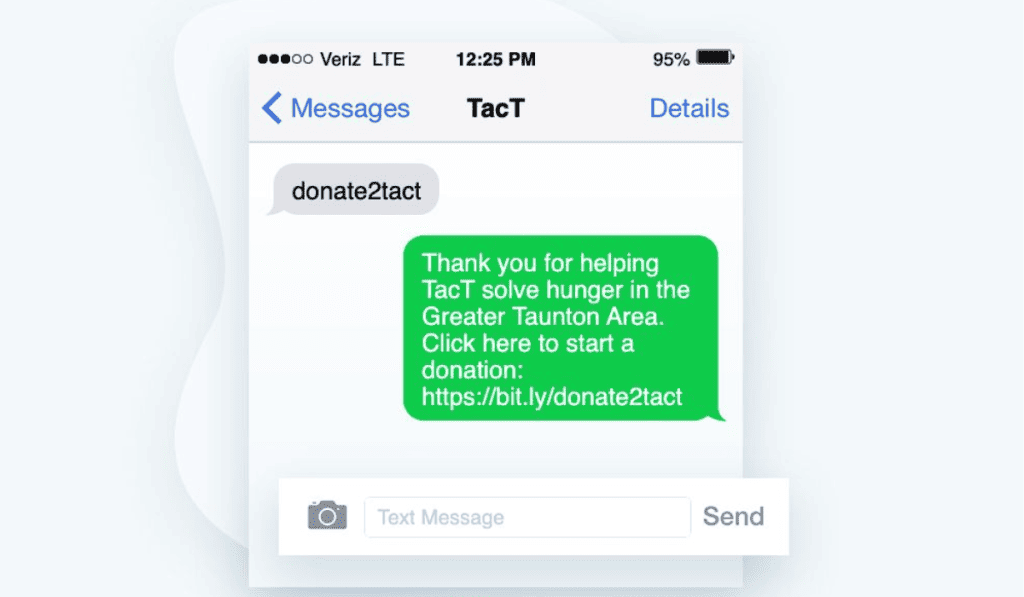
Crafting an effective text donation message involves being concise, clear, and compelling. The message should quickly convey the need, the impact of the donation, and how to take action. Here are some examples that can be adapted for various causes or specific needs within a church or charitable organization:
General Text Donation Messages
- For Immediate Needs: “Your support makes a difference! Text GIVE10 to 70000 to donate $10 to [Church/Charity Name] and help us meet our urgent needs. Your generosity is greatly appreciated!”
- For Specific Projects: “Join us in making a change! Text BUILD to 80000 to contribute $25 to the [Project Name]. Every penny brings us closer to our goal!”
- For Recurring Gifts: “Become a beacon of hope! Text MONTHLY to 50555 to set up a recurring gift of $20/month to [Church/Charity Name]. Your ongoing support is a lifeline for our community.”
- For Disaster Relief: “Help us respond to the [disaster name]! Text RELIEF to 90999 to donate $50 to [Church/Charity Name] for emergency aid. Your swift action can save lives.”
- For Scholarships or Education Programs: “Invest in the future! Text SCHOLAR to 313131 to donate $30 and support our education programs. Give the gift of knowledge and opportunity!”
- For Annual Appeals: “It’s that time of year again! We rely on your generosity to keep our doors open. Text ANNUAL to 41444 to contribute to our annual fund. Thank you for your faithful giving!”
Holiday or Event-Specific Messages
- Christmas Appeal: “This Christmas, bring joy to others! Text MERRY to 20222 to gift $15 to [Church/Charity Name] and share the holiday spirit with those in need.”
- Easter Campaign: “Celebrate renewal and hope this Easter! Your donation of $20 can change lives. Text RISEN to 501501 and bless someone this season.”
- Thanksgiving Drive: “Give thanks by giving back! Text THANKS to 707070 to donate $10 and provide a warm meal for a family this Thanksgiving.”
Church-Specific Campaigns

- For Building Funds: “Help us lay the foundation for generations to come. Text CORNERSTONE to 80888 to contribute $50 to our building fund. Your legacy starts with this stone!”
- For Mission Trips: “Be a part of our mission without leaving home. Text MISSION to 77977 with your donation and empower our team to serve and spread love abroad.”
- For Community Outreach: “Serve our community with your generosity. Text NEIGHBOR to 50555 and donate $20 to support local outreach. Together, we can make a difference!”
Encouraging Regular Giving

- Start of the Year: “New Year, renewed faith! Support our ministry all year. Text FAITHFUL to 45678 to schedule your monthly gift. Your commitment helps us plan boldly!”
- Mid-Year Boost: “Mid-year is here, and so is the opportunity to make an impact! Text MIDYEAR to 50555 and help us continue our programs with a mid-year gift of $25.”
Remember, when sending text donation messages, it’s important to comply with local regulations regarding text message solicitations and to ensure recipients have opted into receiving such messages from your organization. Always include a way for recipients to opt-out of future messages if they wish.
Here are some tips while crafting a short donation message:
- Be clear and concise : Keep your message short, simple, and easy to understand. Be clear about what the donation will be used for and how it will make a difference.
- Appeal to emotions : People are more likely to donate when they feel a connection to the cause. Use emotional language to connect with donors and inspire them to take action.
- Make it personal : Personalize your message by using stories and examples to illustrate the impact of donations. This will help donors see the real-life impact of their gift.
- Highlight the urgency : Let donors know their support is needed now and their gift can make a real difference. This can increase the urgency and motivate them to donate.
- Show gratitude : Show gratitude for their generosity and let them know how much their support means to you and the cause.
- Use statistics and facts : Facts and statistics can help make your message more persuasive and convincing. It can also help to build trust with your donors.
- Use inclusive language : Use inclusive and welcoming language to all donors, regardless of their background or beliefs.
- Be transparent : Be transparent about how the donation will be used and how it will make a difference. This will build trust with donors and increase the likelihood of repeat donations.
- Make it actionable : Encourage donors to take action by making it easy and straightforward for them to donate. Provide clear instructions on donating and what they can expect in return.
- Keep it relevant : Ensure your message is relevant to the donor and the cause. Use language and messaging that speaks directly to their interests and values.
Now some elements of a good short donation message
- Clear language : A good short donation message should use clear and concise language that is easy to understand. Avoid using jargon or technical terms that may confuse potential donors.
- Emotional appeal : A good short donation message should evoke emotions and connect with the reader personally. This can be achieved by using storytelling, highlighting the impact of donations, or using images and videos.
- A clear call to action : A good short donation message should always have a clear call to action that motivates the reader to take action and donate. This can be as simple as asking for a donation or providing a link to a donation page.
- Personalization : A good short donation message should be personalized to the reader and addressed them directly. This can help to build trust and increase engagement.
- Inclusive language : A good short donation message should use inclusive language that appeals to a diverse range of people and does not exclude or alienate any group.
- Concise : A good short donation message should be short and to the point. Avoid using long paragraphs or complicated language that overwhelms or discourages the reader.
- Relevant : A good short donation message should be relevant to the reader and the cause. It should provide specific information about how their donation will make a difference and the impact it will have.
- Trust-building : A good short donation message should build trust with the reader and provide transparency about how their donation will be used. This can include information about the nonprofit’s track record and mission.
- Urgency: A good short donation message should create a sense of urgency and motivate the reader to take action quickly. This can be achieved by highlighting the need for support or using limited-time offers or matching gifts.
- A clear value proposition : A good short donation message should communicate the value of donating and why the reader should support the cause. This can include information about the nonprofit’s impact and mission.
Final Thoughts
In conclusion, short donation messages can drive action and support for your cause. By incorporating elements such as a personal introduction, an apparent problem and solution, a strong call to action, personalization, gratitude, and a memorable conclusion, you can create a message that connects with your audience and inspires giving.
Remember, the key to a successful short donation message is clear, concise, and compelling. With the right message and approach, you can build momentum and create a lasting impact for your cause. By crafting a thoughtful and practical short donation message, you will set your organization up for success and make a real difference in the lives of those you serve.
Nonprofit Strategist & Marketing Maven
With deep expertise in nonprofits, Tejas Rane began his journey at Donorbox, gaining respect for charities’ global impacts. His writings, a fusion of extensive knowledge and marketing acumen, spotlight and celebrate the essential work of nonprofits, inspiring action within the philanthropic realm.
Similar Posts
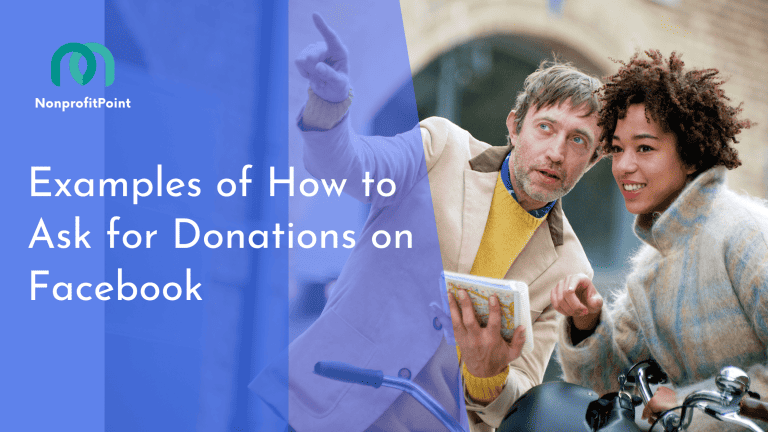
5 Examples of How to Ask for Donations on Facebook (Anatomy & Tips Included)
Asking for donations on Facebook can be a powerful tool for non-profits and charitable organizations looking to raise funds and…

15 Creative Raffle Basket Ideas for Adults (With Tips)
Are you on a mission to create the ultimate raffle basket that will make jaws drop and have people clamoring…

50+ Creative Summer Fundraiser Names for Your Next Event
A summer fundraiser is a great way for a nonprofit organization to raise money and awareness for its cause. The…

50 Creative Fundraiser Names for Schools | Nonprofit Point
You’ve probably heard of or even participated in a fundraiser before. Fundraisers are a great way to get your community…

50+ Amazing Halloween Raffle Prize Ideas: Haunt & Flaunt
When the twilight hour of October 31st approaches, and a symphony of costumed footsteps fills the streets, Halloween celebrations transcend…

60+ Memorable Fundraiser Jokes, Puns: Injecting Humour into Fundraising
Step right up, ladies and gentlemen! Get ready to laugh, giggle, and make a difference all at once. In the…

Inspiring Giving Back To The Community Speech Ideas
Aurora Simon

As human beings, we have a social responsibility to give back to our community. Whether it’s through volunteerism, community engagement, or philanthropy, every action we take can make a difference in the lives of others. In this article, we will explore the power of giving back to the community and provide inspiring speech ideas that will motivate and encourage individuals to take action towards positive change.
Table of Contents
Throughout the following sections, we will discuss the importance of giving back, effective strategies for encouraging volunteerism, practical tips for getting involved in community outreach programs, and ways to make a difference in your community. We will also share inspiring stories of successful Giving Back To The Community Speeches and provide answers to frequently asked questions on this topic. Let’s begin our journey towards creating a better world!
Examples of Giving Back To The Community Speech
Here are some resources to help you write your giving back to the community speech. As time goes on, I will update this list with new resources below.
Understanding The Importance Of Giving Back To The Community
Giving back to the community is an important aspect of social responsibility . It involves taking action to improve the well-being of individuals and society as a whole. Community outreach, volunteerism, and philanthropy are some of the ways individuals can give back to their communities.
There are numerous benefits to giving back to the community. It helps to create a sense of belonging and pride in one’s community. It also fosters a culture of kindness and generosity, which can inspire others to get involved.
Community outreach is a powerful tool for creating change. By engaging with individuals and groups within the community, it is possible to identify areas that require improvement and develop strategies for addressing them. This can include initiatives such as food drives, fundraising events, and educational programs.
Volunteerism is another key way to give back to the community. By volunteering time and skills, individuals can make a positive impact on the lives of others. This can include activities such as mentoring, tutoring, and providing support to those in need.
Philanthropy is another important aspect of giving back to the community. By donating to charitable organizations, individuals can support initiatives that are focused on improving the well-being of others. This can include initiatives such as healthcare, education, and environmental conservation.
Overall, giving back to the community is an essential part of social responsibility. It helps to create a better society, fosters a culture of kindness and generosity, and can inspire others to get involved. By engaging in community outreach, volunteerism, and philanthropy, individuals can make a positive impact on the lives of others and contribute to creating a better world.

The Power Of Community Involvement And Engagement
When it comes to giving back to the community, the power of community involvement and engagement cannot be overstated. By working together and pooling resources, individuals and organizations can achieve greater impact and bring about positive change in their communities.
Community involvement can take many forms, from volunteering time and skills to supporting local initiatives and businesses. Philanthropy also plays an important role in community engagement, as it provides resources to fund programs and projects that benefit the community.
One of the key benefits of community involvement and engagement is that it empowers individuals to take an active role in shaping their communities. By participating in local events and initiatives, individuals can build relationships, develop skills, and make a meaningful contribution to their communities.
The Importance Of Philanthropy In Supporting Community Initiatives
Philanthropy plays a critical role in supporting community initiatives, as it provides resources that enable organizations to carry out their missions and serve the needs of the community. Whether through individual donations, corporate giving, or foundation grants, philanthropy can make a significant difference in the lives of people and communities.
In addition to providing financial support, philanthropy can also help to raise awareness and mobilize support for important causes. By leveraging their networks and resources, philanthropic organizations can bring attention to issues that may otherwise be overlooked, and encourage others to get involved.
The Power Of Collaboration In Achieving Positive Change
Collaboration is essential for achieving positive change in communities. By working together, individuals and organizations can pool their knowledge, skills, and resources to address complex social issues and bring about lasting change.
Effective collaboration requires a shared vision, trust, and a willingness to work towards a common goal . It also requires open communication, active listening, and a commitment to learning from one another.
Ultimately, the power of community involvement, philanthropy, and collaboration lies in their ability to bring people together and create a shared sense of purpose. By working towards a common goal, individuals and organizations can achieve great things and create a better world for all.

Inspiring Stories Of Successful Community Service Speeches
Community service speeches have the power to inspire and motivate individuals and communities to take action towards positive change. Here are some inspiring stories of successful speeches:
“There are two kinds of people in this world: those who sit on the sidelines and watch things happen, and those who jump in and make a difference. Which one are you?” This powerful quote was part of a speech given by a local community leader at a fundraising event for a new community center. Her words inspired many in attendance to become more involved in community initiatives and volunteer work.
Another successful community service speech was given by a high school student at a school assembly. She talked about the importance of giving back to the community and shared her personal experiences volunteering at a local animal shelter. Her speech inspired many of her classmates to become more involved in volunteer work.
At a city council meeting, a concerned citizen gave a passionate speech about the need for a new community garden in a low-income neighborhood. Her speech convinced the council to allocate funds for the project, and the garden became a thriving hub for community involvement and engagement.
These inspiring stories show the power of community service speeches in bringing about positive change. By sharing personal experiences, using powerful quotes, and making a compelling case for action, individuals can motivate others to get involved in community initiatives and make a difference in the world.
Effective Strategies For Encouraging Volunteerism
Volunteerism is a vital component of social responsibility, and it can have a significant impact on the community. It’s crucial to encourage more people to volunteer and give back to society. Here are some effective strategies for promoting volunteerism:
- Engage with the community: To promote volunteerism, it’s essential to connect with the community. Reach out to local organizations, schools, and community groups to create partnerships and opportunities for volunteering.
- Highlight the benefits: Emphasize the benefits of volunteering, both for the individual and society. Some of the benefits include developing new skills, meeting new people, and making a positive impact on society.
- Provide flexible opportunities: Make volunteering accessible and flexible to accommodate various schedules and skill sets. Offer opportunities for both short-term and long-term commitments, and provide training and support for volunteers.
- Celebrate successes: Recognize and celebrate the accomplishments of volunteers and the impact they have on society. Share success stories and highlight the positive outcomes to inspire more people to get involved.
- Partner with local businesses: Partnering with local businesses can provide support for volunteer initiatives. Local businesses can offer in-kind donations, sponsor events, or provide volunteers through their employees.
Encouraging volunteerism is essential for creating a stronger and more connected community. By implementing these effective strategies, we can inspire more people to volunteer and make a positive impact on society.

Ways To Get Involved In Community Outreach Programs
Community outreach programs are a great way to give back and make a positive impact on your local community. If you’re wondering where to start or how to get involved, here are some tips and strategies:
1. Research local organizations
Start by researching local organizations that focus on community outreach programs. Look for groups that align with your values and interests. Many organizations have websites that outline their mission and volunteer opportunities.
2. Attend community events
Attending community events is a great way to learn about local organizations and connect with like-minded individuals. Look for events such as charity runs, volunteer fairs, and community festivals.
3. Volunteer with your company or organization
If you work for a company or organization, look for ways to get involved in their community outreach initiatives. Many companies have formal volunteer programs that allow employees to volunteer during work hours.
4. Start your own project
If you have a particular cause or issue that you’re passionate about, consider starting your own community outreach project. This could be as simple as organizing a community cleanup or as complex as starting a nonprofit organization.
“The best way to find yourself is to lose yourself in the service of others.” – Mahatma Gandhi
5. Participate in online communities
There are many online communities and social media groups that focus on community outreach and volunteering. Joining these groups can be a great way to network with other volunteers and learn about new opportunities.
6. Attend training and workshops
Many organizations offer training and workshops for volunteers. These sessions can provide valuable information on community outreach best practices, leadership skills, and other topics relevant to volunteering.
Getting involved in community outreach programs can be a rewarding and fulfilling experience. By taking action and making a positive impact, you can help create a stronger, more vibrant community for everyone.
How To Make A Difference In Your Community
Communities thrive when individuals actively engage and work together towards a common goal. Making a difference in your community can be incredibly rewarding and fulfilling. Here are some practical steps you can take to get started:
- Identify a community need: Take some time to assess the needs of your community. This could be anything from improving education to supporting local businesses.
- Get informed: Research existing community programs and initiatives in your area. This can give you insight into what has already been done and what areas still need attention.
- Join or start a group: Look for groups or organizations that align with your interests and values. If there is no existing group, consider starting one yourself.
- Volunteer your time: Many community organizations and programs rely on volunteers to function effectively. Consider volunteering your time to help out with events, programs, or initiatives.
- Donate resources: If you are unable to volunteer your time, consider making a donation to support a cause or program that aligns with your values.
- Engage with others: Building relationships and connections within your community is key to creating meaningful and lasting change. Attend community events, volunteer opportunities, and connect with organizations and individuals working towards similar goals.
Remember that making a difference in your community is an ongoing process. It requires dedication, persistence, and collaboration. But the rewards of positively impacting the lives of those around you are priceless.

Social Responsibility and Philanthropy: Creating a Better World
Social responsibility and philanthropy are crucial pillars in creating a better world. These concepts focus on helping those in need and bringing about positive change in society. Here are some examples of successful initiatives that have made a significant impact:
Individuals can also make a difference through acts of philanthropy. Here are some ways to get involved:
- Donate to a charity or organization that aligns with your values
- Volunteer your time and skills to a cause you care about
- Support local businesses that prioritize social responsibility
Philanthropy is not just about giving money, but also about making a positive impact in the world. By choosing to support causes that align with your values, you can contribute to creating a better world for all.
If you’re looking to give a speech on giving back to the community, it’s important to have a clear understanding of your audience and their needs. Whether you’re speaking to a group of volunteers, community leaders, or a general audience, the focus of your speech should be on inspiring action towards positive change. Here are some frequently asked questions that can help you prepare for your Giving Back To The Community Speech.
What Should I Include In My Giving Back To The Community Speech?
Your Giving Back To The Community Speech should convey the importance of social responsibility, volunteerism, and community engagement. Share your own experiences of giving back to the community, and how it has impacted your life. Highlight the benefits of volunteering and community involvement, and provide examples of successful community service initiatives. Above all, encourage your audience to take action towards positive change.
How Can I Engage My Audience?
Engage your audience by sharing inspiring stories of successful community service and volunteerism initiatives. Use visuals such as images or videos to convey the impact of community involvement. Encourage participation and interaction by asking questions and providing opportunities for discussion. Finally, provide practical advice and strategies for getting involved in community outreach programs.
What Are Some Tips For Delivering An Effective Speech?
Start by preparing thoroughly and practicing your speech multiple times. Speak clearly and confidently, and use gestures and body language to convey your message. Make eye contact with your audience, and vary your tone and pace to keep them engaged. Use humor and personal anecdotes to connect with your audience, and end your speech with a clear call to action.
How Can I Measure The Impact Of My Speech?
One way to measure the impact of your speech is by soliciting feedback from your audience. Consider providing a survey or questionnaire that asks for feedback on the content, delivery, and effectiveness of your speech. Another way to measure impact is by tracking engagement in community service initiatives following your speech. If you can demonstrate that your speech inspired action towards positive change, you can be confident that it had a meaningful impact on your audience.
About the author

With an enduring passion for human potential, I have dedicated my life to learning, growing, and most importantly, empowering others to discover their own unique paths to self-improvement. As a personal development blogger, I distill the wisdom gathered from various life experiences, books, seminars, and thought leaders to provide you with actionable insights and tools for your own growth. I believe that each one of us is capable of extraordinary things, and my mission is to help you unlock that potential. Join me on this journey of self-discovery, and together let’s cultivate a life filled with purpose, fulfillment, and joy. You can contact us here.
Leave a Reply Cancel reply
Your email address will not be published. Required fields are marked *
Save my name, email, and website in this browser for the next time I comment.
Latest posts

Giving Back To The Community Business: Make an Impact Today
Businesses have a powerful role to play in creating positive social impact and making a difference in their communities. Giving back to the community has become an essential part of corporate social responsibility, demonstrating a commitment to social and environmental causes beyond traditional business operations. Community involvement, social responsibility, and corporate philanthropy have become key…

Giving Back: Inspiring Articles On Giving Back to The Community
Community involvement is a powerful force that can create positive change in the world. Today, I have included inspiring articles on giving back to the community. Whether it’s volunteering at a local soup kitchen, donating to a charity, or simply taking the time to be kind to others, there are countless ways individuals can give…

Inspirational Quotes About the Importance of Giving Back
Giving back is a concept that has been around for centuries. The quotes about importance of giving back cannot be matched by material possessions. Below are some inspirational quotes about the importance of giving back that showcase the power of generosity and kindness: “No one has ever become poor by giving.” – Anne Frank “As…

- school Campus Bookshelves
- menu_book Bookshelves
- perm_media Learning Objects
- login Login
- how_to_reg Request Instructor Account
- hub Instructor Commons
- Download Page (PDF)
- Download Full Book (PDF)
- Periodic Table
- Physics Constants
- Scientific Calculator
- Reference & Cite
- Tools expand_more
- Readability
selected template will load here
This action is not available.

13.7: Sample Outline- Persuasive Speech Using Monroe's Motivated Sequence Pattern
- Last updated
- Save as PDF
- Page ID 90292

- Kris Barton & Barbara G. Tucker
- Florida State University & University of Georgia via GALILEO Open Learning Materials
Speech to Actuate:
Sponsoring a Child in Poverty
Specific Purpose:
to actuate my audience to sponsor a child through an agency such as Compassion International.
Introduction (Attention Step)
I. How much is $38? That answer depends on what you make, what you are spending it for, and what you get back for it. (Grabber)
II. $38 per month breaks down to a little more than $1.25 per day, which is probably what you spend on a snack or soda in the break room. For us, it’s not very much. (Rapport)
III. I found out that I can provide better health care, nutrition, and even education for a child in Africa, South America, or Asia for the $38 per month by sponsoring a child through Compassion International. (Credibility)
IV. If I can do it, maybe you can too: (Bridge)
Through a minimal donation each month, you can make the life of a child in the developing world much better.
In the next few minutes I would like to discuss the problem, the work of organizations that offer child sponsorships, how research shows they really do alleviate poverty, and what you can do to change the life of a child. Body
I. The problem is the continued existence and effects of poverty. (Need Step)
A. Poverty is real and rampant in much of the world.
1. According to a 2018 report of the Secretary General of the United Nations, 9.2% of the world lives on less than $1.90 per day.
a. That is 600 million people on the planet.
2. This number is supported by the World Poverty clock of the World Data Lab, which states that 8% of the world’s population lives in extreme poverty.
a. The good news is that this number is one third of what it was in 1990, mostly due to the rising middle class in Asia.
b. The bad news is that 70% of the poor will live in Africa, with Nigeria labeled the “Poverty Capital of the World,” according to the Brookings Institute.
B. Poverty means children do not get adequate health care.
1. One prevalent but avoidable disease is malaria, which takes the lives of 3000 children every day, according to UNICEF.
2. According to the World Health Organization, diarrheal diseases claimed 2.46 million lives in 2012 and is the second leading cause of death of children under 5.
C. Poverty means children do not get adequate nutrition, as stated in a report from UNICEF.
1. Inadequate nutrition leads to stunted growth.
2. Undernutrition contributes to more than one third of all deaths in children under the age of five.
D. Poverty means children are unlikely to reach adult age, according to the CIA World Fact Book quoted on the Infoplease website.
1. Child mortality rate in Africa is 8.04% (percentage dying before age 5), while in North American is .64%
2. Life expectancy in Sub-Saharan Africa is almost 30 years less than in the U.S.
E. Poverty also means children are unlikely to receive education and be trained for profitable work.
1. Nearly a billion people entered the 21st century unable to read a book or sign their names, states the Global Issues website on Poverty Facts.
2. UNESCO, a part of the United Nations, reports that less than a third of adults in Sub-Saharan Africa have completed primary education.
Transition:
Although in all respects poverty is better in 2019 than it has been in the past, poverty is still pervasive and needs to be addressed. Fortunately, some great organizations have been addressing this for many years.
II. Some humanitarian organizations address poverty directly through child sponsorships. (Satisfaction Step)
A. These organizations vary in background but not in purpose. The following information is gleaned from each organization’s websites.
1. Compassion International is faith-based, evangelical.
a. Around since early 1950s, started in Korea.
b. Budget of $887 Million.
c. Serves 1.92 million babies, children, and young adults.
d. Works through local community centers and established churches.
2. World Vision is faith-based, evangelical.
a. Around since the 1950s.
b. Budget of far over $1 Billion.
c. 60% goes to local community programs but more goes to global networks, so that 86% goes to services.
d. World Vision has more extensive services than child sponsorship, such as water purification and disaster relief.
e. Sponsors three million children across six continents
3. Children International is secular.
a. Around since 1936.
b. Budget of $125 Million.
c. 88% of income goes directly to programs and children.
d. Sponsors children in ten countries on four continents
e. Sponsors X across X continents
4. Save the Children is secular, through…
a. One hundred years of history, began in post WWI Europe.
b. Budget of $880 Million.
c. 87% goes to services.
d. Sponsors 134 million children in 120 countries, including 450,000 in U.S.
5. There are other similar organizations, such as ChildFund and PlanUSA.
B. These organizations work directly with local community, on-site organizations.
1. The children are involved in a program, such as after school.
2. The children live with their parents and siblings.
3. The sponsor’s donation goes for medicine, extra healthy, nutritious food, shoes for school, and other items.
4. Sponsors can also help donate for birthdays and holidays to the whole family to buy food or farm animals.
Of course, any time we are donating money to an organization, we want to be sure our money is being effectively and ethnically used.
III. This concern should be addressed in two ways: Is the money really helping, and are the organizations honest? (Continuation of Satisfaction Step)
A. The organizations’ honesty can be investigated.
1. You can check through Charity Navigator.
2. You can check through the Better Business Bureau-Charity.
3. You can check through Charity Watch.
4. You can check through the organizations’ websites.
B. Secondly, is sponsoring a child effective? Yes.
1. According to Bruce Wydick, Professor of Economics at the University of San Francisco, child sponsorship is the fourth most effective strategy for addressing poverty, behind water purification, mosquito nets, and deworming treatments.
2. Dr. Wydick and colleagues’ work has been published in the prestigious Journal of Political Economy from the University of Chicago.
3. He states, “Two researchers and I recently carried out a study (sponsored by the U.S. Agency for International Development) on the long-term impacts of Compassion International’s child sponsorship program. The study, gathering data from over 10,000 individuals in six countries, found substantial impact on adult life outcomes for children who were sponsored through Compassion’s program during the 1980s and ’90s…In adulthood, formerly sponsored children were far more likely to complete secondary school and had a much higher chance of having a white-collar job. They married and had children later in life, were more likely to be church and community leaders, were less likely to live in a home with a dirt floor and more likely to live in a home with electricity.”
To this point I have spoke of global problems and big solutions. Now I want to bring it down to real life with one example.
IV. I’d like to use my sponsored child, Ukwishaka in Rwanda, as an example of how you can. (Visualization Step)
A. I have sponsored her for five years.
B. She is now ten years old.
C. She lives with two siblings and both parents.
D. She writes me, I write her back, and we share photos at least every two months.
E. The organization gives me reports on her project.
F. I hope one day to go visit her.
G. I believe Ukwishaka now knows her life can be more, can be successful.
We have looked at the problem of childhood poverty and how reliable, stable nongovernmental organizations are addressing it through child sponsorships. Where does that leave you?
V. I challenge you to sponsor a child like Ukwishaka. (Action Step)
A. Although I sponsor her through Compassion International, there are other organizations.
B. First, do research.
C. Second, look at your budget and be sure you can do this.
1. You don’t want to start and have to stop.
2. Look for places you “waste” money during the month and could use it this way.
3. Fewer snacks from the break room, fewer movies at the Cineplex, brown bag instead of eating out.
D. Talk to a representative at the organization you like.
E. Discuss it with your family.
F. Take the plunge. If you do.
1. Write your child regularly.
2. Consider helping the family, or getting friends to help with extra gifts.
I. In this speech, we have taken a look at the state of poverty for children on this planet, at organizations that are addressing it through child sponsorships, at the effectiveness of these programs, and what you can do.
II. My goal today was not to get an emotional response, but a realistically compassionate one.
III. You have probably heard this story before but it bears repeating. A little girl was walking with her mother on the beach, and the sand was covered with starfish. The little girl wanted to rescue them and send them back to the ocean and kept throwing them in. “It won’t matter, Honey,” said her mother. “You can’t get all of them back in the ocean.” “But it will matter to the ones that I do throw back,” the little girl answered.
IV. We can’t sponsor every child, but we can one, maybe even two. As Forest Witcraft said, “What will matter in 100 years is that I made a difference in the life of a child.” Will you make a difference?
AGScientific. (2019). Top ten deadly diseases in the world. Retrieved from http://agscientific.com/blog/2016/04/top-10-deadly-diseases/
Compassion International. (2019). Financial integrity: The impact of our compassion. Retrieved from https://www.compassion.com/about/financial.htm
Children’s International. (2019). Accountability. Retrieved from https://www.children.org/learn-more/accountability
Global Issues. (2013, January 7 ). Poverty facts and stats. Retrieved from https://www.globalissues.org/article/26/poverty-facts-and-stat s
Infoplease. (2019). What life expectancy really means. Retrieved form https://www.infoplease.com/world/health-and-social-statistics/life-expectancy-countries-0
Kharas, H., Hamel, K., & Hofer, M. (2018, Dec. 13). Rethinking global poverty reduction in 2019. Retrieved from https://www.brookings.edu/blog/future-development/2018/12/13/rethinking-global-poverty-reduction-in-2019/
Roser, M. (2019). Child and infant mortality rates. Retrieved from https:// ourworldindata.org/child-mortality
Save the Children. (2019). Financial information. Retrieved from https://www.savethechildren.org/us/a...al-information UNICEF.(2008).
Tracking progress on child and maternal nutrition: A survival and development priority. Retrieved from https://www.unicef.org/media/files/Tracking_Progress_on_Child_and_Maternal_Nutrition_EN_110309.pdf UNICEF 2019.
The reality of Malaria. Retrieved from https://www.unicef . org/health/files/health_africamalaria.pdf United Nations. (2019). Poverty eradication. Retrieved from https://sustainabledevelopment.un.org/topics/povertyeradication
World Vision. (2019). Financial accountability. Retrieved from https:// www.worldvision.org/about-us/financial-accountability-2 Wydick, B., Glewwe, P., & Rutledge, L. (2013).
Does international child sponsorship work? A six-country study of impacts on adult life outcomes. Journal of Political Economy, 121(2), 393–436. https://doi. org/10.1086/670138 Wydick, B. (2012, Feb.).
Cost-effective compassion. Christianity Today, 56(2), 24-29. Wydick, B. (2013). Want to change the world? Sponsor a child. Christianity Today, 57(5), 20–27.
- Skip to main content
- Skip to primary sidebar
- Skip to footer
Service Nation

How To Persuade People To Give To Charity
posted on September 23, 2019

You’ve visited this website because you feel strongly about being of service to other people. More than likely, that means you either give to charity yourself, or you raise money for a charity . Some of you might even do both, and if so we thank you for everything you do!
Raising funds for charity is a difficult thing to do – especially if you’re involved in the front line of the operation. The front line of a charity is the team of people who interact directly with the public, and try to persuade them to part with their hard-earned money for a charitable cause. Anybody who’s done this will tell you how difficult this can be. All you’re doing is trying to bring some cash to a great and deserving cause, but the majority of the public find you an annoyance and an irritation.
You shouldn’t be downhearted by people who try to pour cold water on what you do. It’s a noble way to spend your time, and one that most people would never have the inclination and bravery to try. If more people took an interest in the well-being of charities, as you do, the world would be a better place! We know you’d like to do even better, though, and so we have some thoughts for you on how you can maximize the time you spend when you’re fundraising.
Take Every Rejection As Part Of The Process
A lot of people who are involved in fundraising, whether in person or over the phone, become frustrated by the sheer number of people who either rudely reject them, or completely ignore their existence. This is the wrong approach. Trying to get money out of strangers is like trying to win money at mobile slots. The majority of the times you try, nothing will happen. Far more spins on a Vegas Slots game come up with a losing combination than a winning one. As with mobile slots, though, the very next attempt could be a winner. Also, like mobile slots, you have no idea how big that next win might be! You could receive a massive donation after fifty consecutive rejections.
That’s why it’s vital to deal with each rejection as part of your fundraising process. Thank the people who say no to you – their rejection means you’re not wasting time on them, and you’re now one person closer to your next successful donation. It’s a game of numbers.
Use Encouraging Language
Nobody likes to be asked directly for money. If your lead-in question is ‘would you like to make a donation today?’ you’re using blunt force where subtlety is required. People are more likely to be generous when they feel like they’re becoming part of something larger.
Even if it feels unnatural the first few times you do it, try to use words which make it clear that the person being asked to make a donation is becoming part of the solution, and making a difference. Instead of asking them if they’d like to make a donation, ask them if they would consider becoming a helper? They still realize that they’re going to be asked for money – people aren’t stupid – but you’re encouraging them to think of themselves as doing something good. That’s the feeling they’re buying into. On the topic of feelings, here’s our next tip.
The Power Of Positivity
It’s an absolute, incontrovertible, scientific fact that being generous makes you feel better about yourself . The research has been done, and the conclusion has been reached by people far more qualified than us to say so. Giving to charity should be a happy experience, and pitching to people’s emotions is what gets the most results.
Your charity might be about people or animals who are in need or suffering. The subject matter of your charity might be extremely sad, or even tragic. Bring that into the conversation but don’t dwell on it. Negative emotions won’t get you anywhere. Instead, emphasize what a huge difference the charity can make, and how the situation can be improved. If someone shows interest, tell them what a fantastic thing they would be doing by agreeing to help. Let them know that the success of the charity relies on wonderful people like them. When you’ve secured a donation, don’t stop there. Send them a thank you email or letter. It’s been shown to significantly reduce the number of people who subsequently cancel a direct debit or retract a donation.
Focus On The Singular
There’s a loose rule when it comes to charity appeals – the more people, animals, or other entities involved in the appeal, the more anonymous the appeal becomes. The human brain struggles to visualize large numbers. If they’re told millions of people are starving, people tend to blank the message out. If they’re told one specific person is starving and they can do something about it, they’re more inclined to donate.
Your appeal should have a face, and a story. You might be fundraising for a million children, or ten million dogs, or an entire developing nation, but choose an individual to become the face of that appeal – a real one. Tell your potential charity-givers that individual’s story, and why they’re suffering, and what needs to be done about it. People can buy into an individual account – they go snow-blind trying to deal with thousands of them.
Have Examples Ready
It’s obvious that a donation of one thousand dollars will do more for a charity than one hundred dollars. Using the same logic, one hundred dollars will do more than ten dollars. If people don’t feel like they have a lot to give, then they might not see the point in giving anything because they don’t believe it will make a difference.
This is where it becomes imperative that you have examples to use when it comes to specific amounts. You should be able to tell the people you’re speaking to precisely what ten dollars will do for the charity. Get a great example for twenty-five dollars, and fifty dollars, and one hundred dollars. More importantly, get an example of what can be done with just one single dollar. It might be the most trivial thing in the world, but it must make a difference somewhere down the line. That’s the bigger picture you need your prospective donors to see.
We hope we’ve given you a little more motivation to get out there and do great things; thank you once again for being someone with enough kindness in their heart to do them!
Specific examples of donation benefits
Happiness/Thanks/Positivity
11 ways to give a great fundraising speech

18 Mar 2020

Alan Clayton shows how even the most nervous public speaker can deliver an inspiring fundraising speech
You have organised a wonderful event. The venue is perfect, catering is on time and it’s packed with donors or prospective donors.
Now someone has to speak.
We all know what can go wrong now, so I won’t dwell on that. From analysis of over 100 fundraising speeches I’ve seen or worked on, here’s what works:
Prepare thoroughly
Preparing thoroughly and remembering your speech is about fundraising and not a general advert for the services of your organisation. Being ‘about fundraising’ means you are focussing on three elements, no more.
1. Before the donation
2. The donation
3. After the donation
Don’t make too many points
Great speakers have great content. It is well structured, and they make a very small number of points in every speech they make. Try the below 4-point structure. The secret is you prepare it from 1 to 4 - but deliver it starting at 4 and working backwards to right now.
1. If you give now, this is what will happen immediately.
2. This is how one person’s life will be different tomorrow.
3. This is how a group of people will be different in one year.
4. This is how the world will change, eventually.
Make an emotional connection
Great speakers know that content is only 20% of the gig. They know that making an emotional connection is the rest. They know which emotions create the reaction they want from the audience and they focus on these. They know that emotion comes from tone, body language, stories and charisma much more than it comes from words.
Tell a story
Emotion comes from stories. Good stories have magic moments. Tell the truth and practice telling it well.
Focus on the audience
Great speakers focus on audience reaction, not their own image. They seek to create action, not build credibility.
Play to your strengths
Great speakers use their charisma to the max. Poor speakers focus on their weaknesses and try and make them better. Great speakers couldn’t give a flying stork about their weaknesses – they focus on their strengths and make them so big and so good that nobody notices their weaknesses.
Don’t let criticism put you off
Be decisive in your opinion and don’t try and placate everyone. Action is the objective, even if a few people don’t like you, or disagree with you. Great speakers focus on their target audience and are not bothered by jealous or aggressive naysayers.
Get physical
Great speakers turn their nerves to their advantage. Nerves can create paralysis if you focus on the words, perfect grammar and content. The fear of public speaking is in the amygdala – the oldest part of our brain. It is a fight, flight or freeze reaction. You must not freeze. Therefore the solution to nerves in public speaking is physical: Move around, get the heart rate up, breathe, relax and repeat. Physical actions focus anxiety into energy not paralysis. And, when practiced, they look brilliant.
Use visuals sparingly
Great speakers use visuals only to emphasise key points, not to store the content.
Be yourself
Great speakers find power in being great at being themselves. Poor speakers try and live up to someone else’s stereotype of a good speaker. Don’t do that. Find what’s best about being you and focus on that. You will find this by exploring authenticity, and you will discover that authenticity comes from vulnerability. Find and exploit your vulnerabilities.
Be supported
Great speakers have a team to inspire and support them. Training and creativity are just as important in speaking as they are in any other form of communication.
Great public speakers inspire people, create action and raise a lot of money. Make sure you are one and so are your CEO, chair, board of trustees, project staff, fundraisers and all volunteers. Enjoy!
Alan Clayton is founder and creative director at Revolutionise
This article was originally posted on 06/10/2015.
Related Posts

Words of Wisdom: “Find your purpose”

4 ways fundraising managers can successfully lead their teams

Fundraising first-hand: How to better empathise with beneficiaries
Get the latest fundraising advice and insight.

Fundraising Info
- Ask the Experts
- Case Studies
- Charity Profile
- Free Reports
- From the IOF
- How To Guides
- Infographics
- Special Focus
- Training & Events
- Trends & Research
Fundraising Type
- Campaigns & Appeals
- Charity Retail & Auctions
- Corporate Fundraising & Partnerships
- Crowd Funding
- Direct Marketing
- Door to Door Fundraising
- Event Fundraising
- General Fundraising
- Grants & Funding
- Individual Giving
- International Fundraising
- Investment Management
- Legacies & In Memory
- Local & Community Fundraising
- Lottery funding
- Major Donor & Philanthropy
- Multichannel Fundraising
- Online & Mobile Fundraising
- Payroll Giving
- Small Charity Fundraising
- Street Fundraising
- Telephone Fundraising
Fundraising Support
- Charity Management
- Charity Partnerships and Mergers
- Charity Twinning
- Communications
- Crisis Management
- Data Management
- Donor Management & Behaviour
- Impact Reporting & Measurement
- Income Diversification
- Insurance & Financial Management
- Policy & Regulatory
- PR & Marketing
- Products & Services
- Recruitment & HR
- Social Enterprise
- Social Investment
- Social Media & SEO
- Technology & Digital
- Training & Development
404 Not found

Charity Speech

When you hear the word charity and speech in a sentence , what is the first thing that comes to mind? You may think that this is about asking for donations for a disease that is incurable like cancer. Others may think it is about asking for help to build a new place or a new building in school. The least of the majority may also think that it would be about giving money to someone who may have been in the hospital and their families are not able to pay for the medical bills, so they are asking for those who would not mind giving anything to help.
All of which is true and more. People who make speeches about charity are not only asking for help or donations, they are also in a way thanking those who have helped them to make a difference. However, there are also ways in making charity speeches sound so persuasive that their audience seem to feel guilty if they are not able to help out. What happened when you did? Was it as scary as a lot of people would say? Don’t worry, though, you’re not going to be making any speeches here. Did you know that what you write in your speech is as important as how you present it? Check out 10+ charity speech examples now.
10+ Charity Speech Examples
1. persuasive charity speech.
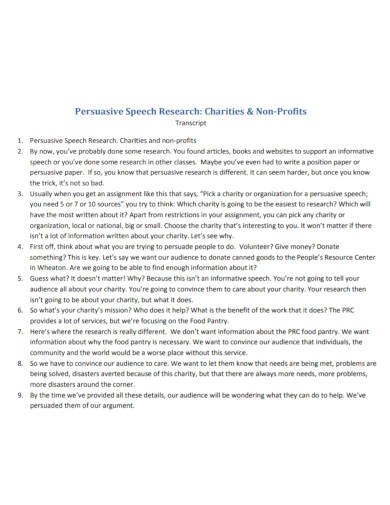
Size: 64 KB
2. Annual Charity Speech

Size: 14 KB

3. Formal Charity Speech

Size: 104 KB
4. University Charity Speech

Size: 336 KB
5. Cancer Charity Speech

Size: 270 KB
6. Amendment Protection of Charitable Speech

Size: 351 KB
7. Speech for President at Charity

Size: 100 KB
8. Charity Committee Speech
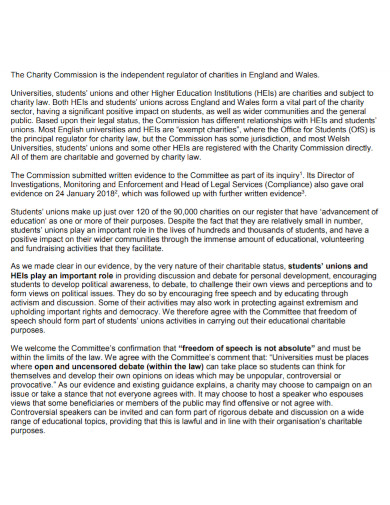
Size: 328 KB
9. Student Charity Speech
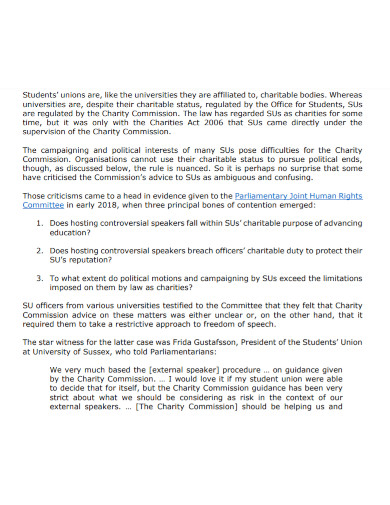
Size: 707 KB
10. Charity Conference Speech

Size: 95 KB
11. Speech Contest for Charity

Size: 35 KB
What Is a Charity Speech?
What do you think is a charity speech and why do you think it is important to know how to write one? A charity speech is a kind of speech that a person or a representative makes in order to ask in kind. A speech that is made to persuade people who listen to donate for things that they may not be using anymore to someone else. In addition to that, it can also be used as a way to ask for monetary donations for hospitals, buildings or places where people could find ways to cure incurable diseases. A charity speech can also be used as a way to persuade people to do things that they may not think about like giving a huge sum of money or a huge sum of their time to someone who may need it. It is basically a way to ask for something with a good reason. The purpose of a charity speech is to be polite enough to ask for donations without making it sound like a requirement for those who may listen to your speech.
How to Write a Charity Speech?
Are you looking for a way to deliver and to write a good charity speech for a special event? If so, here are some five tips to help you get there. How to write a good charity speech and added with how to deliver them with ease. Go right ahead then.
1. Prepare Your Notes for Your Speech
To be able to make such a good and convincing speech, always prepare your own notes. Your notes are merely key words that you want to add in your speech. They serve as an outline or a road map so you would not have to lose what you are planning to talk about. Prepare your notes in advance so as to not to panic and forget everything completely.
2. Tell a Story
One way to make connections with your audience is by telling them a story. This story should also connect with your charity speech. The best way to tell a story is to tell one that is real. As much as possible, find a story that may fit with the theme of your speech and use it. A lot of people relate more when a speech is accompanied by an anecdote or a story.
3. Make a Connection With Your Audience
This means that, when you read your speech out loud, avoid not making eye contact with your audience. Rather, do eye contact. Make a connection with your audience, let them feel what you are trying to tell them. In other words, let them know how you are feeling as you make your speech. Let them understand that this speech is about donating to the less fortunate and their donations can help in more ways than one.
4. Focus More on What You Offer
This is a continuation of tip number three. Focus more on what you are trying to tell them or you are trying to offer. Make them understand or make them see why it is good to donate and it is good to give even a simple share of what they have. Basically the power of persuasion is the key to this when you are making fundraising speeches like this.
5. Thank the People
Last but not the least is to thank everyone who has joined you today or who has joined in on the activity. Thanking people in your speech does not only make it sound like you are happy to have them here, but it is also showing that you are polite and respectful enough to have them here. In a way that they may or may not be able to help with the fundraising activity, you must always thank them for their time.
Is a charity speech and a fundraising speech the same?
A charity speech is an example of a fundraising speech. A charity speech is a kind of speech given when you are asking for donations of an important kind. This speech often gives audiences a reason to donate or to do fundraising activities for the greater good.
What are sample topics for a charity speech?
Your topic can range from asking for donations to medicinal research, feeding the world poor or simply asking for donations for education. As long as you are aware of the topic you plan on talking about.
What should be avoided when making fundraising speeches?
There are a lot of things you need to take into consideration when making speeches. One of which is never use any words that may cause your audience to misinterpret them. Stick to the keywords on your notes when you want to say something to connect with your speech. Avoid not making any eye contact as you present.
Giving charity speeches can give a person a sense of importance in a good way. It gives them the opportunity to share and to ask for donations in a sensible and polite manner. But just like any other kind of speech, you must be careful how you word things. You must understand that there are some things that are better off unsaid.
Charity Speech Generator
Text prompt
- Instructive
- Professional
Create a charity speech for a fundraising campaign launch
Help me write a charity speech for a gala dinner
This campaign closed on Dec 31, 2016 Alex Merriam brought clean water to Rijia Elhaji Abdou .
Persuasive Speech
organized by Alex Merriam
Help Alex Merriam give the gift of clean water. 100% of every donation raised will fund charity: water's work providing access to clean water projects around the world.

Many of us have no idea what it's like to be thirsty. We have plenty of water to drink -- even the water in our toilets is clean!
But many people around the world don’t have that luxury. Every day, about 1,400 children die from diseases caused by unsafe water and poor sanitation. But it doesn’t have to be that way. There are simple solutions like drilled wells, spring protections and BioSand filters that help provide clean water to communities around the world.
I started this fundraising campaign to help charity: water build these types of projects around the world, and I'm looking for anyone who can help me.
Please donate to my campaign -- anything you can give is a huge help.
100% of the money will be used to build clean water projects, and when they’re complete, charity: water will send us photos and GPS coordinates so we can see the exact community we helped.
- A Anonymous donated $29 to Persuasive Speech over 7 years ago
- A Alex Merriam donated $1 to Persuasive Speech over 7 years ago
- 1 A Anonymous $29
- 2 A Alex Merriam $1
Alex Merriam has partially funded 1 project.
raised and sent to the field
est. people served
This campaign raised $30. That money is hard at work in the field.
100% of the money raised by this campaign is being used to bring clean water to help those in need. In 21 months we’ll be able to show you exactly where the money went and who it helped.


Top Three Tips to Master Donor Persuasion
Persuasion gets a bad rap, and it’s time to change that. Think about it – what sorts of imagery come to mind when you think of somebody who possesses a persuasive quality?
Different people think of different things. For me, when somebody says persuasion I see a car salesperson doing anything they can to “get you in this car today.”
At its core, persuasion simply means getting somebody to understand where you’re coming from so well that they decide they want to believe it too. We need more of that in the nonprofit sector, especially when asking for donations.
There are various instances where you’ll need to possess a persuasive quality. Basically, persuasion happens any time you’re trying to sell somebody on your organization. For example:
- Chatting with somebody at a fundraising event who is on the fence about your organization.
- Explaining to random strangers when they ask you, “So, what do you do?”
- Any time you’re working to cultivate a returning or potential donor.
- When you’re trying to sway someone to join your board.
Those are just a few examples of where persuasion comes in handy in the nonprofit sector. Now let’s talk about how to do it. Check out these three things to remember next time you’re in a position where you need to persuade someone to love your organization just as much as you do.
1. Remember why you started.
“Fake it ‘til you make it” is a good tactic for some things in life, but this isn’t one of them. The one thing you can’t fake in this industry is your genuine love for the cause. It’s easy to tell if your heart just isn’t in something.
That’s why the first aspect to persuasion is genuine conviction. If you have an infectious love for your organization, others will see that and it’ll help ignite their sparks.
“The one thing you can’t fake in this industry is your genuine love for the cause.”
2. Remember the 3 Cs.
When in doubt, there are three Cs that you can memorize to ensure your conversation heads in the right direction.
Be Clear. Branding consistency is key. If a constituent or potential donor were to hear inconsistencies with your message, it would cause trust issues. Convey the right message in a clear manner for the best results.
Be Concise. Similar to an elevator pitch, you only have so much time to capture someone’s attention. Avoid redundancies and cut out information that isn’t pertinent to proving your point.
Be Calm. When you’re nervous, the donor will be nervous whether they admit it or not. People will either consciously or subconsciously take notice of a quivering voice or shaky hands. If subconsciously, they’ll most likely feel uneasy which will ultimately hurt your chances of successful persuasion.
How can you avoid it if you genuinely have stage fright ? There are steps you can take, many of which include practicing so that the message is second nature.
3. Remember, it’s bigger than a donation.
When a business makes an elevator pitch to a potential investor, they might most likely be pitching for a major investment and then going on their merry way. Nonprofits don’t pitch for one sum of cash. Nonprofits cultivate .
“Nonprofits don’t pitch for one sum of cash. Nonprofits cultivate .”
If you’re trying to persuade a potential donor simply to give, you’re making a big mistake. Instead, you should be trying to persuade donors to love your organization. Sure, there’s an element of genuine love that has to be there in order to show somebody the light regarding your organization, but remember that you have the power to take that light and turn it into a sun.
Looking for even more tips? Check out these 21 principles of persuasion from Forbes.

Lyndsey Hrabik
Featured | fundraising, july 5, 2016, you may also enjoy.

How to Turn Your Nonprofit’s Social Followers into Donors
Whether or not you've built a strong following, here are some tips will help you expand your social audience and, ultimately, your donor base.
Feb 6, 2024 | 5 Minute Read

5 Ways to Boost Donor Retention in 2024
5 Ways to Boost Donor Retention in 2024 You worked hard during the year-end giving...
Dec 28, 2023 | 6 Minute Read

How To Attract Donors For Your Nonprofit’s Success
How To Attract Donors For Your Nonprofit's Success Finding donors for your nonprofit isn't just...
Nov 16, 2023 | 8 Minute Read
Become a Member
Whether you’re with a large team or a solo entrepreneur looking to start the next great cause, we have a membership package that will help you grow your network and your cause.

Speech on Charity
Charity is a beautiful act of kindness. It’s when you help others by giving your time, money, or goods. You might do it to support people, animals, or even the environment.
Doing charity can make you feel good inside. It’s a way to show love and care for those who need it.
1-minute Speech on Charity
Good day, everyone. Today, we are going to talk about a beautiful thing called ‘charity’.
Charity is when we help others who need it. It’s like sharing your lunch with a friend who forgot theirs. When we do charity, we give a part of what we have to people who have less. It can be money, clothes, food, or even time.
Why should we do charity? Well, imagine you are very cold and someone gives you a warm blanket. You would feel happy, right? That’s exactly how people feel when we help them. It brings joy to their lives. And the beautiful part is, it makes us happy too.
But charity is not just about giving things. It’s about showing kindness and love. When we help others, we show them that they matter, that they are not alone. This gives them hope and strength to face their problems.
Charity also makes our world a better place. When we help others, we spread love and kindness. This helps in reducing sadness and suffering in the world.
In conclusion, charity is a powerful way to show love and kindness. It brings joy to people and makes our world a better place. So, let’s all try to do a little bit of charity every day. Because every act of kindness, no matter how small, can make a big difference in someone’s life. Thank you.
Also check:
- Essay on Charity
- Advantages and Disadvantages of Charity
2-minute Speech on Charity
Hello, friends! Today, let’s talk about something truly special – charity. Charity is the act of giving help to those in need. It can be money, food, clothes, or even your time. It’s like sharing a piece of your heart with someone who needs it more than you do.
Why do we need charity? Imagine a world where everyone has enough to eat, a safe place to live, and a chance to go to school. Sounds perfect, right? But the truth is, we live in a world where many people don’t have these basic things. They need our help. And that’s where charity comes in. It’s our way of showing kindness and love to those who need it the most.
Charity is not just about giving money. It’s about making a difference. When you give a toy to a child who has none, you’re bringing a smile to their face. When you give food to a hungry family, you’re giving them strength. When you donate books to a school, you’re helping children learn and grow. Every act of charity, big or small, changes the world in its own way.
But charity is not just good for those who receive it. It’s also good for those who give it. When you help others, you feel good about yourself. You learn to appreciate what you have. You realize that even if you don’t have a lot, you can still make a difference. Giving makes you happy, and that’s a feeling money can’t buy.
So how can we practice charity? It’s simple. Look around you. There are people in need everywhere. Maybe it’s a neighbor who can’t afford groceries. Maybe it’s a friend who needs help with homework. Maybe it’s a homeless person who needs a warm meal. All you need to do is reach out and lend a hand.
Remember, charity doesn’t always mean giving away things. You can also give your time. You can volunteer at a local food bank, tutor a child, or help clean up a park. Every minute you spend helping others is a gift of love.
In conclusion, charity is a powerful way to make the world a better place. It’s a way to show kindness and love. It’s a way to bring hope to those who need it. So let’s make a promise today. Let’s promise to give more, to help more, to love more. Because every act of charity, no matter how small, makes a big difference. Thank you.
- Speech on Characteristics Good Public Delivery
- Speech on World Toilet Day
- Speech on Changing Role Of Women
We also have speeches on more interesting topics that you may want to explore.
Leave a Reply Cancel reply
Your email address will not be published. Required fields are marked *
Save my name, email, and website in this browser for the next time I comment.

Improve your practice.
Enhance your soft skills with a range of award-winning courses.
Persuasive Speech Outline, with Examples
March 17, 2021 - Gini Beqiri
A persuasive speech is a speech that is given with the intention of convincing the audience to believe or do something. This could be virtually anything – voting, organ donation, recycling, and so on.
A successful persuasive speech effectively convinces the audience to your point of view, providing you come across as trustworthy and knowledgeable about the topic you’re discussing.
So, how do you start convincing a group of strangers to share your opinion? And how do you connect with them enough to earn their trust?
Topics for your persuasive speech
We’ve made a list of persuasive speech topics you could use next time you’re asked to give one. The topics are thought-provoking and things which many people have an opinion on.
When using any of our persuasive speech ideas, make sure you have a solid knowledge about the topic you’re speaking about – and make sure you discuss counter arguments too.
Here are a few ideas to get you started:
- All school children should wear a uniform
- Facebook is making people more socially anxious
- It should be illegal to drive over the age of 80
- Lying isn’t always wrong
- The case for organ donation
Read our full list of 75 persuasive speech topics and ideas .

Preparation: Consider your audience
As with any speech, preparation is crucial. Before you put pen to paper, think about what you want to achieve with your speech. This will help organise your thoughts as you realistically can only cover 2-4 main points before your audience get bored .
It’s also useful to think about who your audience are at this point. If they are unlikely to know much about your topic then you’ll need to factor in context of your topic when planning the structure and length of your speech. You should also consider their:
- Cultural or religious backgrounds
- Shared concerns, attitudes and problems
- Shared interests, beliefs and hopes
- Baseline attitude – are they hostile, neutral, or open to change?
The factors above will all determine the approach you take to writing your speech. For example, if your topic is about childhood obesity, you could begin with a story about your own children or a shared concern every parent has. This would suit an audience who are more likely to be parents than young professionals who have only just left college.
Remember the 3 main approaches to persuade others
There are three main approaches used to persuade others:
The ethos approach appeals to the audience’s ethics and morals, such as what is the ‘right thing’ to do for humanity, saving the environment, etc.
Pathos persuasion is when you appeal to the audience’s emotions, such as when you tell a story that makes them the main character in a difficult situation.
The logos approach to giving a persuasive speech is when you appeal to the audience’s logic – ie. your speech is essentially more driven by facts and logic. The benefit of this technique is that your point of view becomes virtually indisputable because you make the audience feel that only your view is the logical one.
- Ethos, Pathos, Logos: 3 Pillars of Public Speaking and Persuasion
Ideas for your persuasive speech outline
1. structure of your persuasive speech.
The opening and closing of speech are the most important. Consider these carefully when thinking about your persuasive speech outline. A strong opening ensures you have the audience’s attention from the start and gives them a positive first impression of you.
You’ll want to start with a strong opening such as an attention grabbing statement, statistic of fact. These are usually dramatic or shocking, such as:
Sadly, in the next 18 minutes when I do our chat, four Americans that are alive will be dead from the food that they eat – Jamie Oliver
Another good way of starting a persuasive speech is to include your audience in the picture you’re trying to paint. By making them part of the story, you’re embedding an emotional connection between them and your speech.
You could do this in a more toned-down way by talking about something you know that your audience has in common with you. It’s also helpful at this point to include your credentials in a persuasive speech to gain your audience’s trust.

Obama would spend hours with his team working on the opening and closing statements of his speech.
2. Stating your argument
You should pick between 2 and 4 themes to discuss during your speech so that you have enough time to explain your viewpoint and convince your audience to the same way of thinking.
It’s important that each of your points transitions seamlessly into the next one so that your speech has a logical flow. Work on your connecting sentences between each of your themes so that your speech is easy to listen to.
Your argument should be backed up by objective research and not purely your subjective opinion. Use examples, analogies, and stories so that the audience can relate more easily to your topic, and therefore are more likely to be persuaded to your point of view.
3. Addressing counter-arguments
Any balanced theory or thought addresses and disputes counter-arguments made against it. By addressing these, you’ll strengthen your persuasive speech by refuting your audience’s objections and you’ll show that you are knowledgeable to other thoughts on the topic.
When describing an opposing point of view, don’t explain it in a bias way – explain it in the same way someone who holds that view would describe it. That way, you won’t irritate members of your audience who disagree with you and you’ll show that you’ve reached your point of view through reasoned judgement. Simply identify any counter-argument and pose explanations against them.
- Complete Guide to Debating
4. Closing your speech
Your closing line of your speech is your last chance to convince your audience about what you’re saying. It’s also most likely to be the sentence they remember most about your entire speech so make sure it’s a good one!
The most effective persuasive speeches end with a call to action . For example, if you’ve been speaking about organ donation, your call to action might be asking the audience to register as donors.
Practice answering AI questions on your speech and get feedback on your performance .
If audience members ask you questions, make sure you listen carefully and respectfully to the full question. Don’t interject in the middle of a question or become defensive.
You should show that you have carefully considered their viewpoint and refute it in an objective way (if you have opposing opinions). Ensure you remain patient, friendly and polite at all times.
Example 1: Persuasive speech outline
This example is from the Kentucky Community and Technical College.
Specific purpose
To persuade my audience to start walking in order to improve their health.
Central idea
Regular walking can improve both your mental and physical health.
Introduction
Let’s be honest, we lead an easy life: automatic dishwashers, riding lawnmowers, T.V. remote controls, automatic garage door openers, power screwdrivers, bread machines, electric pencil sharpeners, etc., etc. etc. We live in a time-saving, energy-saving, convenient society. It’s a wonderful life. Or is it?
Continue reading
Example 2: Persuasive speech
Tips for delivering your persuasive speech
- Practice, practice, and practice some more . Record yourself speaking and listen for any nervous habits you have such as a nervous laugh, excessive use of filler words, or speaking too quickly.
- Show confident body language . Stand with your legs hip width apart with your shoulders centrally aligned. Ground your feet to the floor and place your hands beside your body so that hand gestures come freely. Your audience won’t be convinced about your argument if you don’t sound confident in it. Find out more about confident body language here .
- Don’t memorise your speech word-for-word or read off a script. If you memorise your persuasive speech, you’ll sound less authentic and panic if you lose your place. Similarly, if you read off a script you won’t sound genuine and you won’t be able to connect with the audience by making eye contact . In turn, you’ll come across as less trustworthy and knowledgeable. You could simply remember your key points instead, or learn your opening and closing sentences.
- Remember to use facial expressions when storytelling – they make you more relatable. By sharing a personal story you’ll more likely be speaking your truth which will help you build a connection with the audience too. Facial expressions help bring your story to life and transport the audience into your situation.
- Keep your speech as concise as possible . When practicing the delivery, see if you can edit it to have the same meaning but in a more succinct way. This will keep the audience engaged.
The best persuasive speech ideas are those that spark a level of controversy. However, a public speech is not the time to express an opinion that is considered outside the norm. If in doubt, play it safe and stick to topics that divide opinions about 50-50.
Bear in mind who your audience are and plan your persuasive speech outline accordingly, with researched evidence to support your argument. It’s important to consider counter-arguments to show that you are knowledgeable about the topic as a whole and not bias towards your own line of thought.
- IELTS Scores
- Life Skills Test
- Find a Test Centre
- Alternatives to IELTS
- Find Student Housing
- General Training
- Academic Word List
- Topic Vocabulary
- Collocation
- Phrasal Verbs
- Writing eBooks
- Reading eBook
- All eBooks & Courses
- Sample Essays
- Donating to Charity Essay
Donating Money to Charity Essay
In this donating money to charity essay for IELTS you have two sides of an argument to discuss.
This is the question:
Some people prefer to provide help and support directly to those in need. Others however prefer to give money to national and international charitable organisations.
Discuss both these views and give your own opinion.
Understanding & Organising the Essay
You can identify the two different arguments from the words " Some people prefer... " and " Others however prefer... ".
So you need to make sure you discuss both of these views, and of course say what you personally think: "... and give your own opinion."
In this donating money to charity essay, the writer presents the first argument in the first body paragraph, the next argument in the second, then their personal opinion in the conclusion.
This is a logical and simple way to do it but of course it can be approached in slightly different ways (check out some of the other " discuss two opinion " model essays to see other ways).
Now take a look at the model answer.

You should spend about 40 minutes on this task.
Write about the following topic:
Give reasons for your answer and include any relevant examples from your own experience or knowledge.
Write at least 250 words.
Model Answer
Giving money to those in need can be a personally satisfying experience, but there is a choice between donating nationally and internationally through charities or giving directly to those around you. This essay will consider the merits of both approaches.
The first advantage of providing direct support is that you can know exactly how your money is being spent. For example, if you give money directly to people in your local village or town, you can see where it has gone. When you donate to larger charitable organisations, on the other hand, you are not sure how much will actually be given to those in need as opposed going on other costs such as administration and expensive marketing campaigns. Another benefit is that you can see the impacts on those you are helping, which can lead not only to great personal satisfaction but also to respect from others in the local community who appreciate the work you do.
There are advantages, however, in giving to charities that are national and international. First and foremost there is the choice of good causes. Locally the kinds of places to help may be limited, but in larger organisations you can get involved in such activities as sponsoring a child or conserving wildlife. Not only this, donating to larger charities with an international reach means having the knowledge that you are involved in issues of fundamental global importance, such as curing diseases and human rights, or helping those caught up in tragic environmental events, such as flooding, earthquakes and famines.
In conclusion, given the benefits of both, I would argue that an individual should make their own choice based on their personal preferences and whichever provides them with the most personal satisfaction. What is crucial is that we continue to give to those who are more in need than ourselves.
(306 Words)
This donating money to charity essay should achieve a high IELTS score in the test for a number of reasons.
Firstly the introduction opens by letting the reader know what the topic is and the two sides of the argument under consideration.
This is then followed by a clear thesis statement to clarify what the essay is going to do.
- This essay will consider the merits of both approaches.
Coherence and cohesion are good because it's very easy to read and follow the arguments in each paragraph and to see clearly that each body paragraph has one controlling idea i.e.
- Body 1 : Benefits of providing help and support directly to those in need
- Body 2: Benefits of donating to national and international charities
Transitional phrases and words are also used well to guide the user through the ideas:
- The first advantage of providing direct support is...
- For example...
- ...on the other hand...
- Another benefit is that...
- ...not only..but also...
- There are advantages, however,...
- First and foremost...
- Not only this,...
- In conclusion,...
The conclusion gives the writer's opinion very clearly.
The essay also has a wide range of grammatical structures and a high level of grammatical accuracy.
<<< Back
Next >>>
More Discuss Two Opinion Essays:

Extraterrestrial Life Essay: Should we look for life on other planets?
This extraterrestrial life essay is an IELTS opinion essay where you have to discuss both sides of an issue then give your own opinion.

IELTS Essays: What is the best way to reduce crime?
IELTS essays online with comments by an IELTS instructor - A writing sample on the topic of reducing crime.

Childcare Essay: Should family or carers look after young children?
Childcare Essay: In the essay you have to discuss two sides of an argument. The first is that it is better if pre-school children are looked after at home with relatives such as grandparents. The second opinion is that children should be looked after at childcare centres.

Sources for Stories Essay: Should parents read to their children?
This sources for stories essay asks for your opinion on the best way for children to get stories. Is it from parents reading to them or other ways?
Formal and Informal Education Essay: What age should it start?
This formal and informal education essay is about whether it is best for children to begin their formal education at school when they are 7 rather than much younger.

Animal Rights Essay: Should animals be exploited for humans?
Animal Rights Essay for IELTS: Learn how to write an essay where you have to discuss two opinions. People who believe in animal rights think that they should not be treated cruelly, for example in experiments or for sport.

IELTS Writing Example: What are the aims of a university education?
IELTS writing example essays. This is an essay on the aims of university education. In this essay, two opposing opinions need to be discussed. It is important to understand how to answer this type of question in the IELTS exam.

Influence of Scientists or Politicians Essay
Influence of Scientists or Politicians Essay- Model answer for IELTS. Who has had the most influence on our world? In this essay you have to discuss both sides.

Zoo Essay: Are zoos cruel or do they protect animals?
This is a recent zoo essay question from the IELTS test (June 2018). Essay about zoos have come up a few times in the IELTS test so it's worth studying same sample questions and sample essays about the topic.

Child Development Essay: What factors influence a child's development?
Child Development Essay for IELTS. The essay is about the factors that affect the way that children develop. It provides you with a model answer and comments on the response to help you know how to improve your band score.

Diet and Health Essay: Who is responsible for diet and health?
Diet and Health Essay for IELTS: This model examines the extent to which individuals or governments should be responsible for health. Read a model answer and useful comments about the essay which will help you to improve your IELTS Score.

IELTS Essay Becoming Independent
This IELTS essay discussed whether people are becoming more independent than they were in the past. This is a question that has come up a few times in the test. This is discussion type essay as you have to discuss both sides of an argument and come to a conclusion.
Any comments or questions about this page or about IELTS? Post them here. Your email will not be published or shared.
Before you go...
Check out the ielts buddy band 7+ ebooks & courses.

Would you prefer to share this page with others by linking to it?
- Click on the HTML link code below.
- Copy and paste it, adding a note of your own, into your blog, a Web page, forums, a blog comment, your Facebook account, or anywhere that someone would find this page valuable.
Band 7+ eBooks
"I think these eBooks are FANTASTIC!!! I know that's not academic language, but it's the truth!"
Linda, from Italy, Scored Band 7.5

IELTS Modules:
Other resources:.
- All Lessons
- Band Score Calculator
- Writing Feedback
- Speaking Feedback
- Teacher Resources
- Free Downloads
- Recent Essay Exam Questions
- Books for IELTS Prep
- Student Housing
- Useful Links

Recent Articles
Decreasing House Sizes Essay
Apr 06, 24 10:22 AM

Latest IELTS Writing Topics - Recent Exam Questions
Apr 04, 24 02:36 AM

IELTS Essay: English as a Global Language
Apr 03, 24 03:49 PM

Important pages
IELTS Writing IELTS Speaking IELTS Listening IELTS Reading All Lessons Vocabulary Academic Task 1 Academic Task 2 Practice Tests
Connect with us
Copyright © 2022- IELTSbuddy All Rights Reserved
IELTS is a registered trademark of University of Cambridge, the British Council, and IDP Education Australia. This site and its owners are not affiliated, approved or endorsed by the University of Cambridge ESOL, the British Council, and IDP Education Australia.
- International
- Schools directory
- Resources Jobs Schools directory News Search
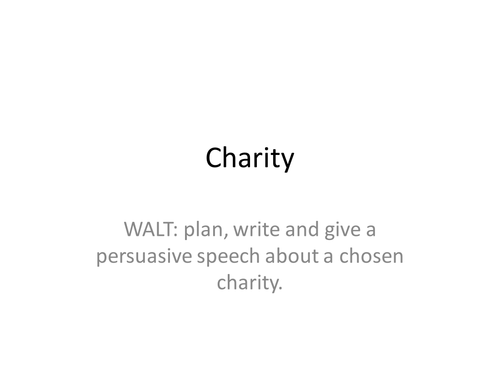
Writing to Persuade: Charity Speech
Subject: English
Age range: 11-14
Resource type: Worksheet/Activity
Last updated
16 June 2016
- Share through email
- Share through twitter
- Share through linkedin
- Share through facebook
- Share through pinterest

Creative Commons "Sharealike"
Your rating is required to reflect your happiness.
It's good to leave some feedback.
Something went wrong, please try again later.
TES Resource Team
We are pleased to let you know that your resource Writing to Persuade: Charity Speech, has been hand-picked by the Tes resources content team to be featured in https://www.tes.com/teaching-resources/blog/english-debates-and-speeches in April 2024 on https://www.tes.com/teaching-resources/blog. Congratulations on your resource being chosen and thank you for your ongoing contributions to the Tes Resources marketplace.
Empty reply does not make any sense for the end user
ANGIEMEROLA
Very useful resource
rhilovelife
well done to whoever made this you've really helped my layout and understanding x
Thanks. Really glad you liked it! 😁
Report this resource to let us know if it violates our terms and conditions. Our customer service team will review your report and will be in touch.
Not quite what you were looking for? Search by keyword to find the right resource:

Donald Trump Fundraiser May Have Broken the Law
A fundraising event hosted by a charitable organization and linked to Donald Trump may have broken the law if it explicitly benefited his campaign, as an IRS rule bars charities from endorsing candidates for elections.
Border911, a Trump-backed charitable organization led by Tom Homan, his former Immigration and Customs Enforcement chief, hosted a gala on April 4 that Trump attended. Other attendees included former presidential candidate Vivek Ramaswamy and Matt Whitaker, who served as chief of staff at the Department of Justice under Trump.
The nonprofit group campaigns against illegal immigration and seeks to persuade swing voters to vote for border security, without explicitly telling them to support Trump . According to the invitation, tickets for the event ranged from $1,200 to $100,000.
Concerns have been raised that the organization may be breaking the law with its links to Trump. The Border911 Foundation received its charitable tax exemption from the IRS in August 2023, which prohibits it from participating in partisan political campaigns.
According to IRS rules, charities "are absolutely prohibited from directly or indirectly participating in, or intervening in, any political campaign on behalf of (or in opposition to) any candidate for elective public office." The IRS can revoke a charity's status if it violates these rules, according to the agency's website.
Newsweek has contacted a representative for Trump and Border911 for comment by email.
On X, formerly Twitter , Eric Lisann, a former federal and state prosecutor, wrote that if the fundraiser benefited Trump, the organization could risk losing its tax-exempt status, and Trump and others could also be taxed on the private benefits.
In March, when asked about Border911's compliance with IRS rules, Homan told ABC News that any problematic messaging was "unintentional." He added, "We are making changes quickly to ensure we stay in compliance with [federal] rules."
"They understand now that they can't endorse a candidate either overtly or covertly," Steve Lentz, an attorney working with Border911, told ABC News.
Anything improper that may have happened "is inadvertent, it's not intentional. And Tom is very committed to cleaning it up," Lentz said. "As a former law enforcement officer, he wants to follow the [law]."
Lentz also said he and Homan were in the process of registering a 501(c)(4) entity with the IRS that Border911 could use to participate in political activities. These organizations can intervene in elections and lobby members of Congress , but donations they receive are not tax-deductible.
Related Articles
- How Old Is Donald Trump and When Is His Birthday?
- Donald Trump's Financial Empire Is Undergoing a Major Restructure
- Judge Overseeing Trump Organization Finds Major Errors in Accounts
Start your unlimited Newsweek trial


IMAGES
VIDEO
COMMENTS
2. Hi ghlight your organization's achievements and goals. Outline your nonprofit's achievements. Be passionate and excited at how far you've come! This won't be superficial or fake passion if you ask someone who is truly grateful for your nonprofit organization and will share their story during your fundraising speech.
This way it is easier for you to persuade your audience with just a few words here and there. 3. Add the Compelling Details. This is the body of your speech. Add the compelling details of your charity speech. You may also add an anecdote here or a compelling story to persuade your audience to donate.
Short Donation Message Examples for Hospitals. "Save a life today with a simple donation. Your generosity can provide vital medical care to those in need.". "Your donation can bring comfort, healing and hope to those in their greatest time of need.". "Invest in the health and well-being of our community.
Giving back to the community is an important aspect of social responsibility. It involves taking action to improve the well-being of individuals and society as a whole. Community outreach, volunteerism, and philanthropy are some of the ways individuals can give back to their communities. There are numerous benefits to giving back to the community.
13.7: Sample Outline- Persuasive Speech Using Monroe's Motivated Sequence Pattern ... Of course, any time we are donating money to an organization, we want to be sure our money is being effectively and ethnically used. ... You can check through Charity Watch. 4. You can check through the organizations' websites.
Let them know that the success of the charity relies on wonderful people like them. When you've secured a donation, don't stop there. Send them a thank you email or letter. It's been shown to significantly reduce the number of people who subsequently cancel a direct debit or retract a donation. Focus On The Singular.
Tell stories. 5. Be conversational. 6. Add humor. 7. Here's what else to consider. Writing a speech for a charity fundraiser can be a daunting task. You want to inspire your audience to donate ...
1. Before the donation. 2. The donation. 3. After the donation. Don't make too many points. Great speakers have great content. It is well structured, and they make a very small number of points in every speech they make. Try the below 4-point structure. The secret is you prepare it from 1 to 4 - but deliver it starting at 4 and working ...
A charity speech is a type of persuasive speech that aims to inspire the audience to support a cause, donate money, or take action. To make a lasting impact, you need to craft a strong opening and ...
People what makes speeches about charity am cannot only asking for help or donations, they are also in a way thank those any have helped yours for make a difference. However, there are also ways in making charity speeches acoustic consequently persuasive that their viewer seem to feel guilty if they are did able to help out.
Prepare your notes in advance so as to not to panic and forget everything completely. 2. Tell a Story. One way to make connections with your audience is by telling them a story. This story should also connect with your charity speech. The best way to tell a story is to tell one that is real.
2 Use storytelling. Storytelling is one of the most effective ways to capture your audience's attention and inspire them to donate. Stories can make your cause more relatable, memorable, and ...
Past campaigns. Persuasive Speech. Ended Dec 31, 2016. Raised $30. Many of us have no idea what it's like to be thirsty. We have plenty of water to drink -- even the water in our toilets is clean! But many people around the world don't have that luxury. Every day, about 1,400 children die from diseases caused by unsafe water and poor sanitation.
When asking donors to part with money, a good way for them to donate enthusiastically is to inform them just how their participation will effect your organization or cause.
3. Remember, it's bigger than a donation. When a business makes an elevator pitch to a potential investor, they might most likely be pitching for a major investment and then going on their merry way. Nonprofits don't pitch for one sum of cash. Nonprofits cultivate. "Nonprofits don't pitch for one sum of cash. Nonprofits cultivate."
Advantages and Disadvantages of Charity; 2-minute Speech on Charity. Hello, friends! Today, let's talk about something truly special - charity. Charity is the act of giving help to those in need. It can be money, food, clothes, or even your time. It's like sharing a piece of your heart with someone who needs it more than you do.
Persuasive Speech Outline, with Examples. A persuasive speech is a speech that is given with the intention of convincing the audience to believe or do something. This could be virtually anything - voting, organ donation, recycling, and so on. A successful persuasive speech effectively convinces the audience to your point of view, providing ...
Comments. This donating money to charity essay should achieve a high IELTS score in the test for a number of reasons. Firstly the introduction opens by letting the reader know what the topic is and the two sides of the argument under consideration.. This is then followed by a clear thesis statement to clarify what the essay is going to do.. This essay will consider the merits of both approaches.
If so, you know that persuasive research is different. It can seem harder, but once you know the trick, it's not so bad. 3. Usually when you get an assignment like this that says, "Pick a charity or organization for a persuasive speech; you need 5 or 7 or 10 sources" you try to think: Which charity is going to be the easiest to research?
Persuasive Speech: Donating Organs In Mississippi And Mississippi. Beverly Gholar Mrs. Reid SPT11113-9MWF 16 April 2014 Persuasive Speech Outline Specific Purpose: To persuade my audience that organs are in need in Mississippi and Mississippi should allow a person to donate their organs without any consent. Introduction: I.
Close. In my communication course, I presented a persuasive speech about why you should donate blood. I chose this topic for my presentation because I believe that donating blood is an important activity every person should do if they are able. I made a slideshow with google slides. I enjoy making presentations...
Writing to Persuade: Charity Speech. Subject: English. Age range: 11-14. Resource type: Worksheet/Activity. File previews. pptx, 264.58 KB. Powerpoint guiding learners through the planning, writing and delivery of a speech persuading listeners to donate money to a charity of their choice. Creative Commons "Sharealike".
Persuasive Speech For Donating to Charity Purpose: At the end of my presentation, the audience will feel more of a want to donate to charities, whether it is 1 cent or 5 dollars. They will realize the impact of what such little donations can do. Introduction: Hi, I'm Allie Cushley and I love service and helping the community. I think donating money to charities is something really important ...
The nonprofit group campaigns against illegal immigration and seeks to persuade swing voters to vote for border security, without explicitly telling them to support Trump.According to the ...